A Mexican garden is a celebration of life, color, and texture, transforming any outdoor area into a vibrant and inviting retreat. This design style, deeply rooted in Spanish and indigenous traditions, emphasizes the beauty of natural materials and bold, expressive hues. It masterfully blends rustic charm with lush, often drought-tolerant, plant life to create a space that is both visually stunning and deeply relaxing. By incorporating iconic elements such as hand-painted tiles, sculptural cacti, and the soothing sound of water, you can craft an authentic hacienda-style oasis that serves as a perfect extension of your home.
1. A Mexican Garden with Talavera Tile Accents
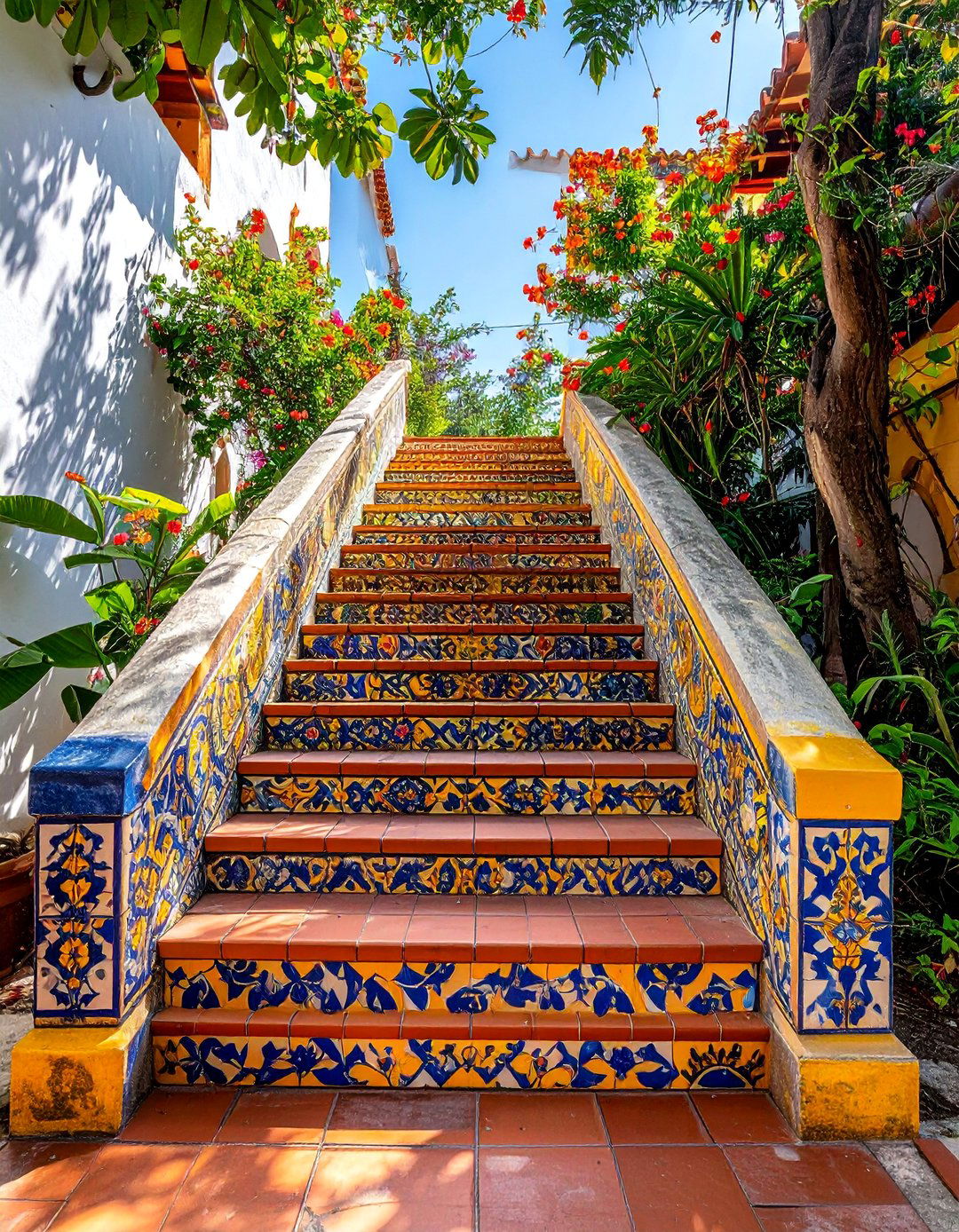
Incorporating Talavera tiles is a hallmark of Mexican garden design, instantly adding intricate patterns and a splash of vibrant color. These hand-painted ceramic tiles are perfect for decorating stair risers, creating a bold backsplash for an outdoor kitchen, or embedding into a patio floor as a decorative mosaic. You can also use them to frame a doorway or as a border for a raised garden bed. The combination of brilliant blues, yellows, and terracotta tones against stucco walls or stone pathways creates a stunning visual contrast that is quintessentially Mexican, infusing the space with artistic flair and historical charm.
2. A Bold Cobalt Blue Wall in a Mexican Garden
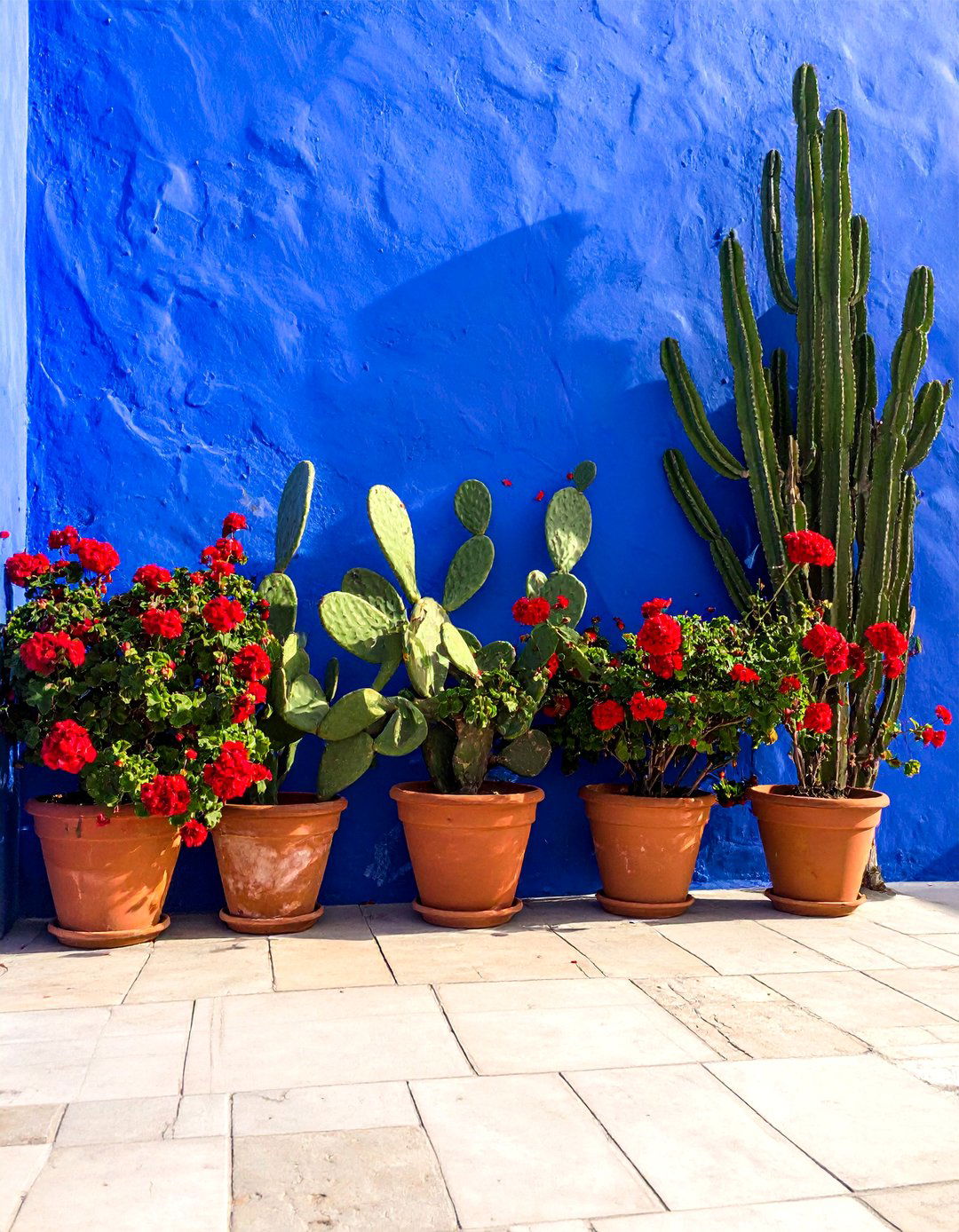
One of the most striking features of a Mexican garden is the use of a bold, saturated color palette, with cobalt blue being a classic choice. Painting a single courtyard or boundary wall in this intense hue creates a dramatic backdrop that makes surrounding greenery and flowers pop. This color, famously used in Frida Kahlo's garden, Casa Azul, evokes a sense of both tranquility and vibrancy. A cobalt blue wall serves as the perfect canvas for climbing bougainvillea, contrasting beautifully with its bright pink or purple blooms, and provides a stunning setting for rustic wooden benches and terracotta planters.
3. A Cacti and Succulent Collection in a Mexican Garden
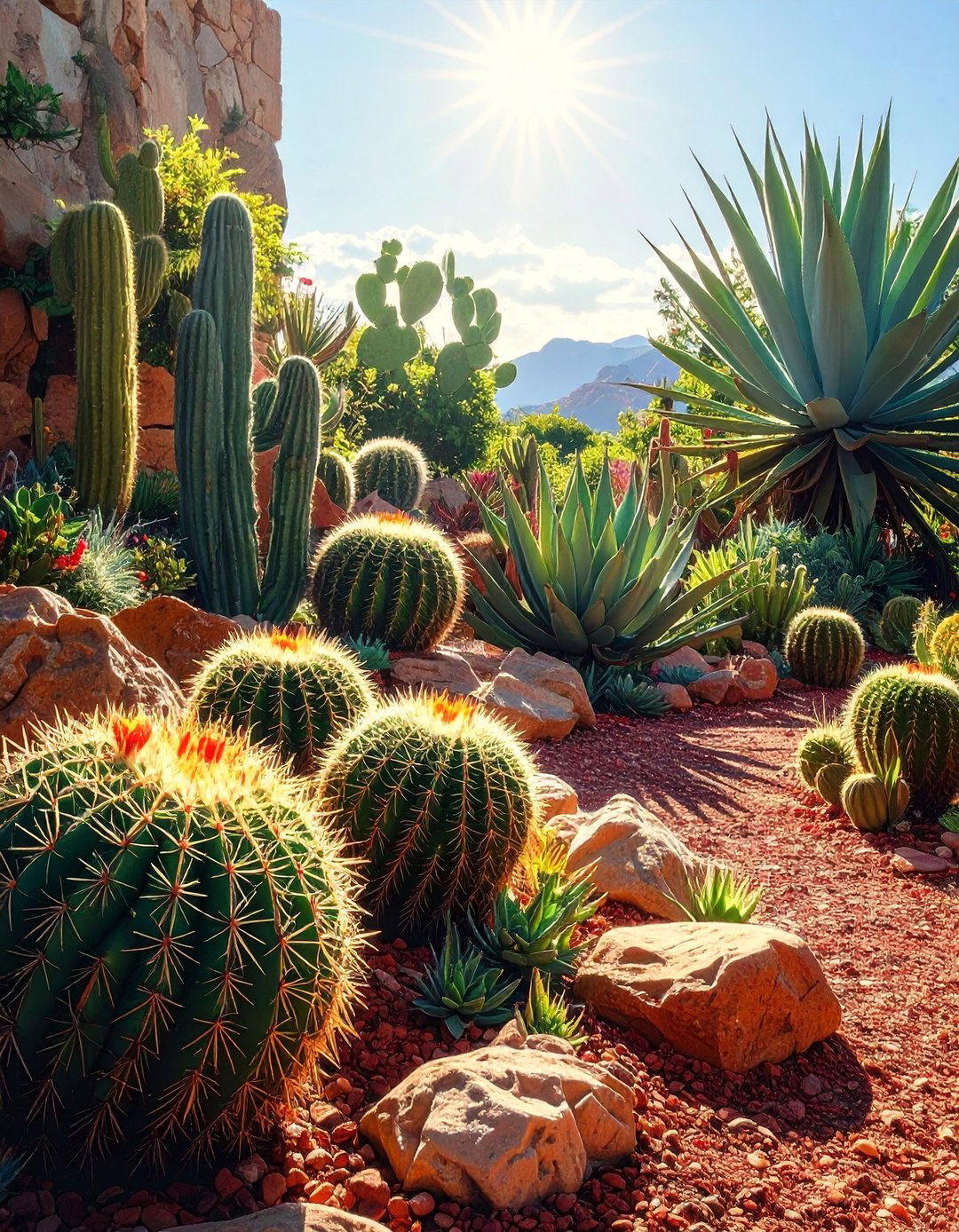
A collection of cacti and succulents forms the structural backbone of a classic Mexican garden. These drought-tolerant plants offer a fascinating array of shapes, sizes, and textures, from the tall, architectural form of the organ pipe cactus to the rosette patterns of echeverias and the spiky spheres of barrel cacti. Group them together in a dedicated rockery or arrange them in various terracotta pots to create sculptural interest. Agaves and yuccas can serve as dramatic focal points. This low-maintenance planting style not only conserves water but also perfectly captures the rugged, natural beauty of Mexico’s arid landscapes.
4. A Cantera Stone Fountain in a Mexican Garden
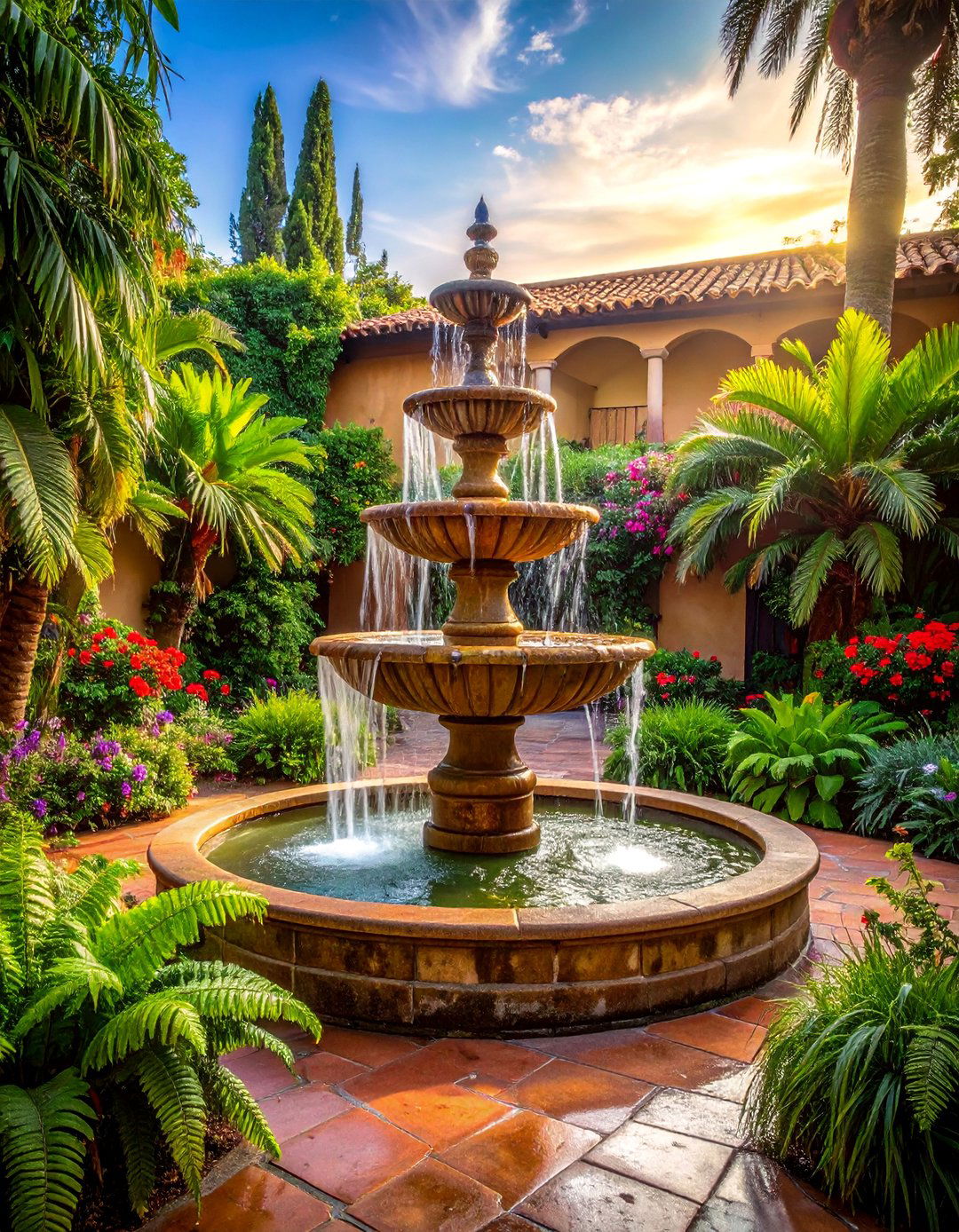
The soothing sound of trickling water is a central element in a Mexican garden, and a Cantera stone fountain provides an authentic and elegant focal point. This volcanic stone, prized for its porous texture and natural, earthy tones, is traditionally carved into multi-tiered fountains or simple wall-mounted spouts. Placed in the center of a courtyard or against a colorful wall, a Cantera fountain adds a sense of cooling serenity and old-world charm. Its rustic appeal complements the surrounding terracotta, tile, and lush foliage, creating a peaceful sanctuary that invites relaxation and contemplation in your outdoor space.
5. A Bougainvillea-Draped Pergola in a Mexican Garden
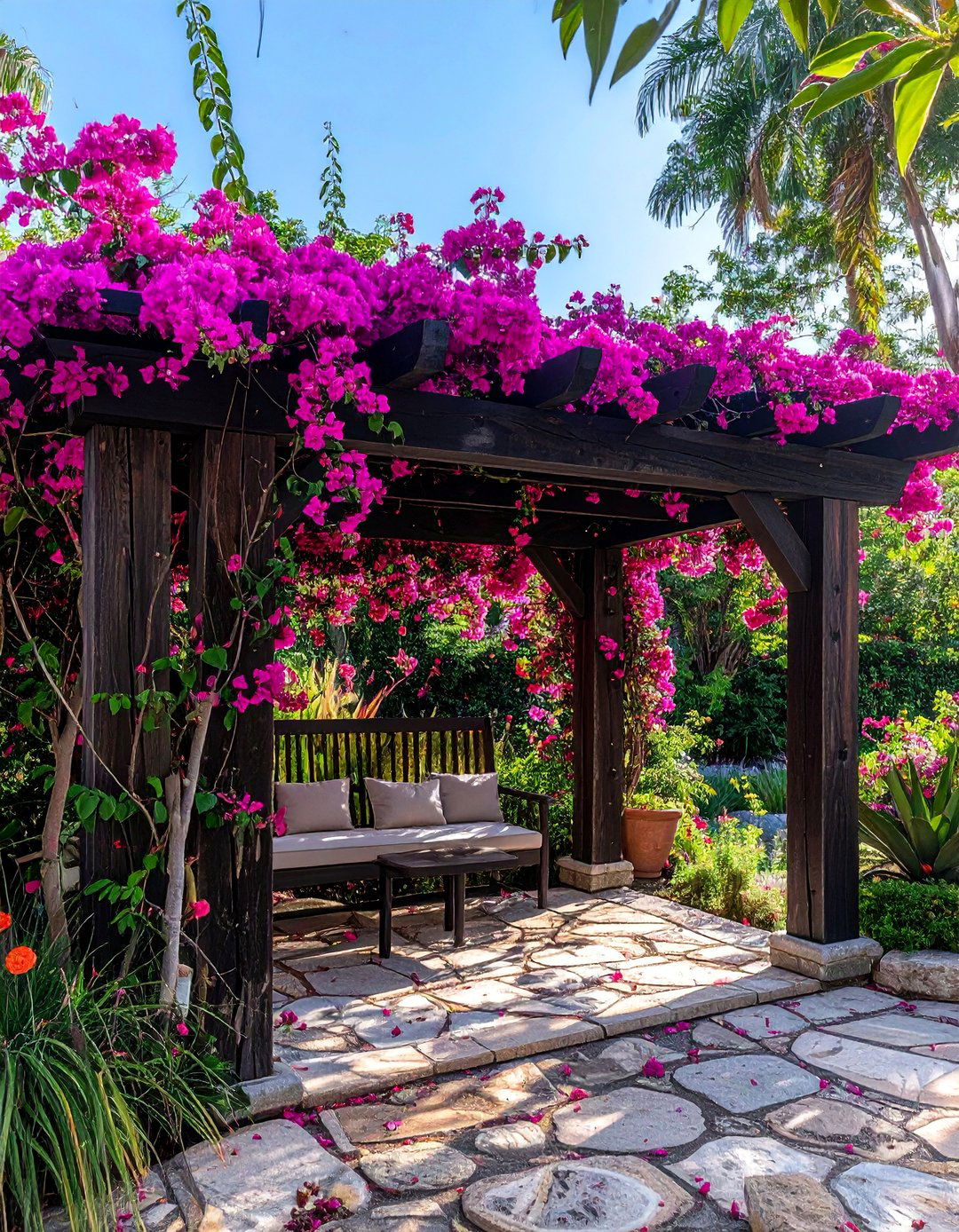
A rustic wooden pergola offers essential shade and architectural structure, and draping it with bougainvillea infuses the space with breathtaking color. This vigorous vine thrives in sunny climates and produces a profusion of paper-like bracts in vibrant shades of magenta, pink, orange, or white. As the bougainvillea climbs and covers the wooden beams, it creates a stunning natural canopy over a seating area or walkway. This living ceiling provides a cool, shaded retreat from the sun while adding a romantic and quintessentially Mexican touch, filling your garden with an explosion of brilliant, eye-catching color.
6. A Rustic Wooden Bench in a Mexican Garden
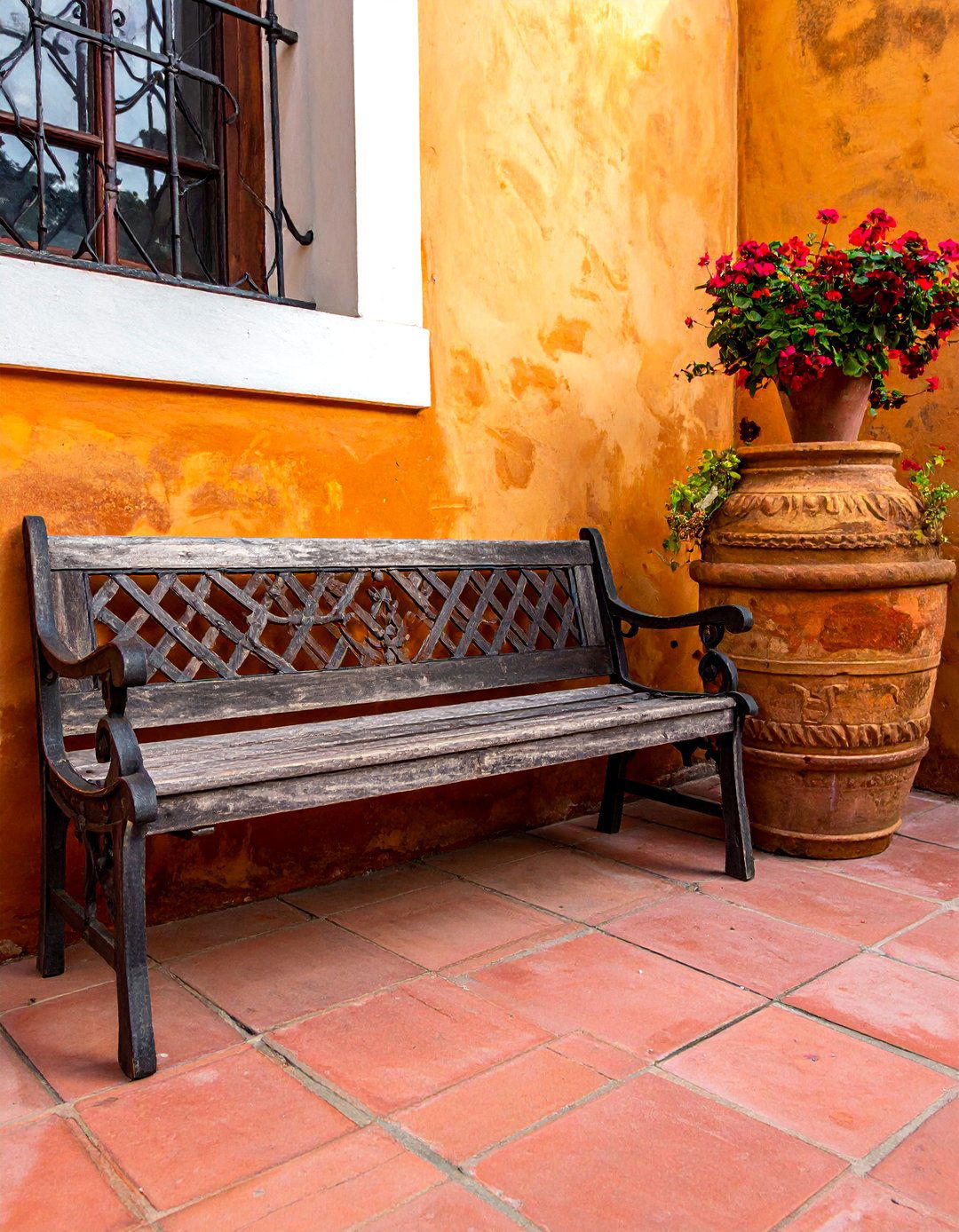
Adding rustic wooden furniture is essential for creating an authentic and inviting seating area in a Mexican garden. Look for heavy, distressed wood benches, perhaps with carved details or wrought iron accents, that evoke the feel of a traditional hacienda. Placed against a brightly colored stucco wall, beneath a shady tree, or alongside a stone pathway, a rustic bench provides a perfect spot for rest and reflection. The natural, weathered texture of the wood contrasts beautifully with the smoothness of plaster walls and the vibrant colors of nearby tiles and flowering plants, enhancing the garden's rustic charm.
7. Terracotta Pot Groupings in a Mexican Garden
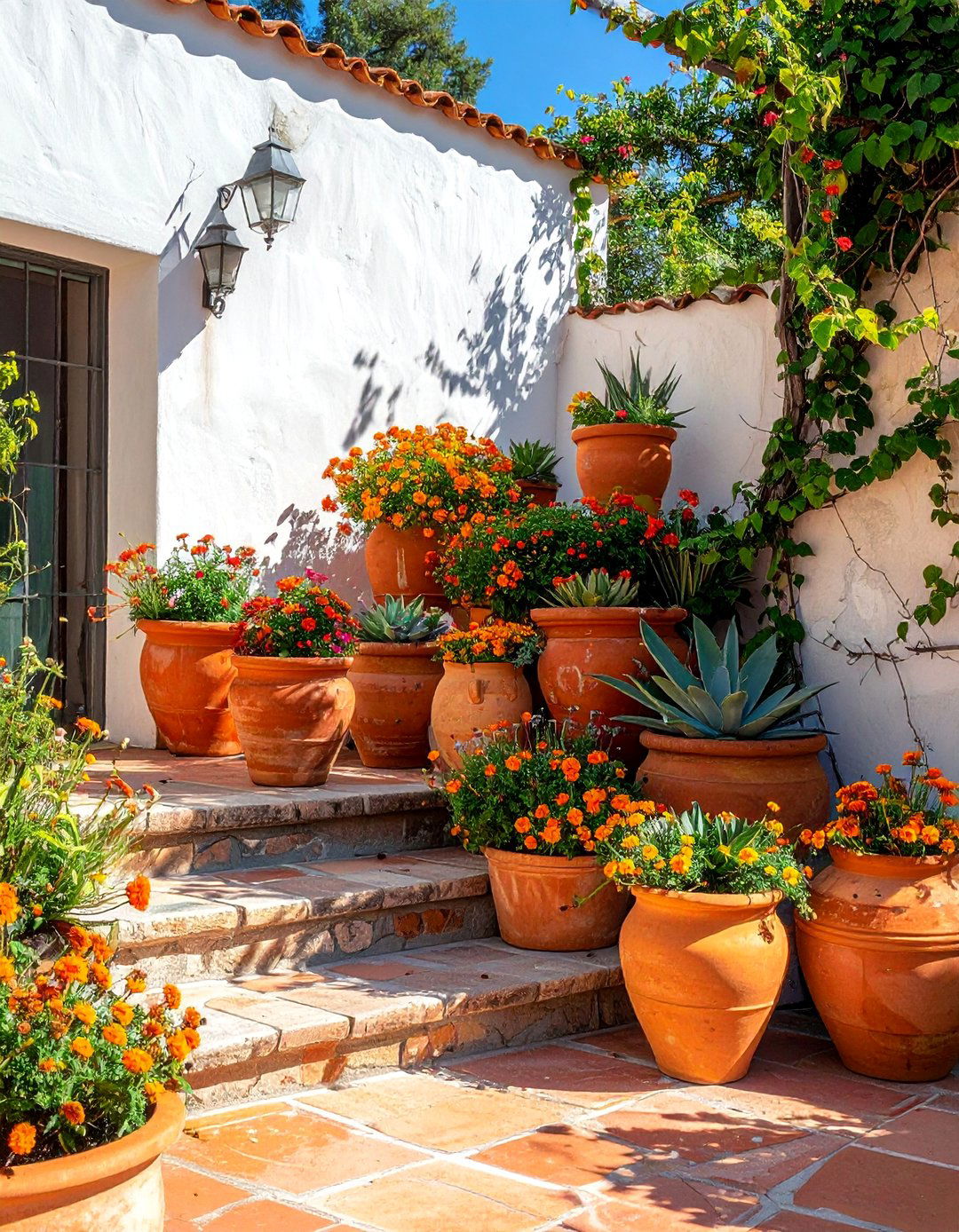
Grouping terracotta pots of various shapes and sizes is a simple yet highly effective way to create a classic Mexican garden aesthetic. The warm, earthy tones of the unglazed clay are a perfect complement to the vibrant colors and green foliage typical of this style. Arrange a cluster of pots on a patio, along a staircase, or in a sunny corner, planting them with a mix of succulents, geraniums, and marigolds. This layered approach adds depth and interest to the space, allowing you to easily introduce different plant textures and colors while maintaining a cohesive, rustic, and sun-baked look.
8. A Wrought Iron Gate in a Mexican Garden
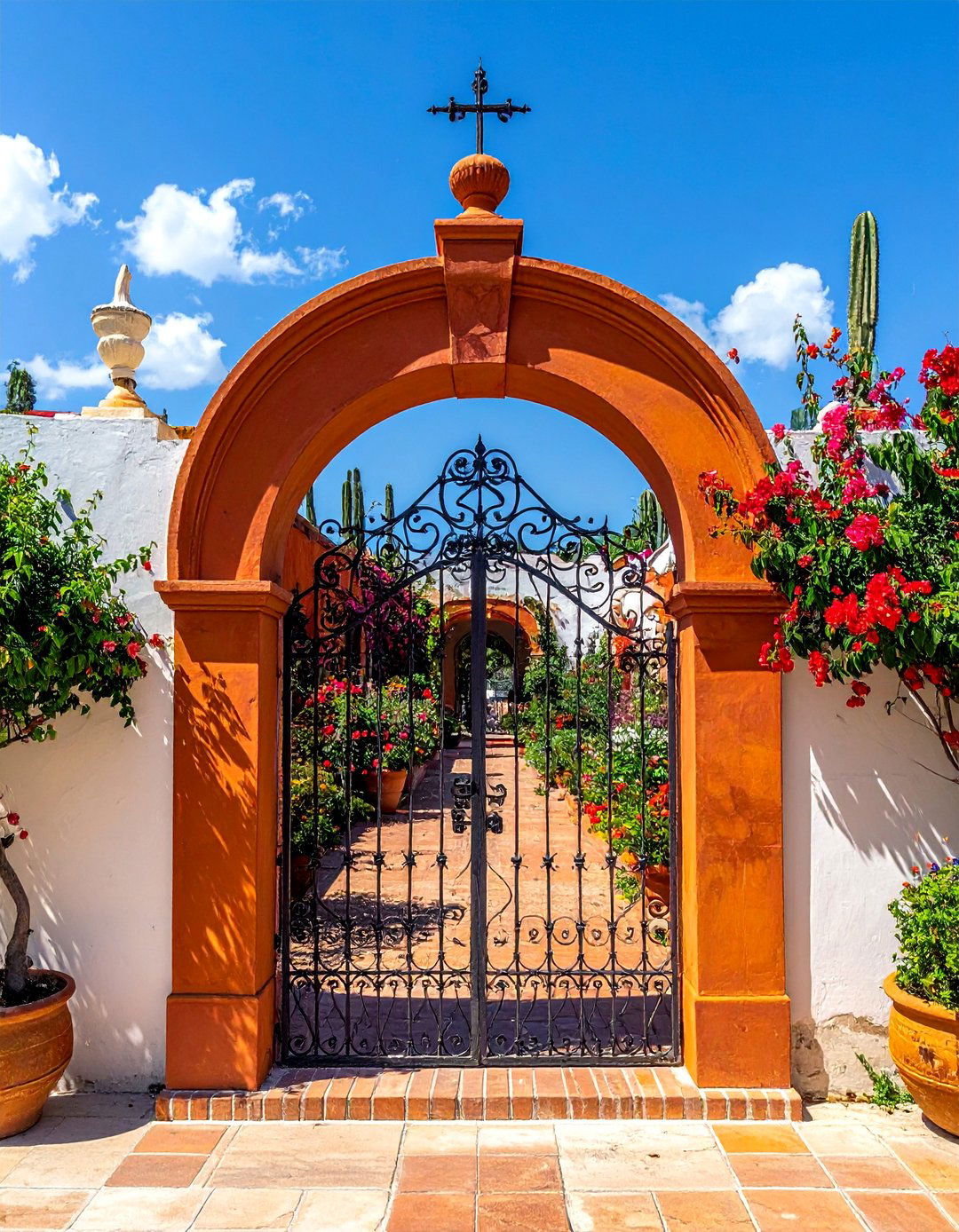
A wrought iron gate serves as a beautiful and functional entry point, immediately setting a traditional hacienda tone for your Mexican garden. Intricate scrollwork and classic Spanish-inspired designs add a touch of elegance and old-world craftsmanship. Whether used as a grand entrance to the entire garden or as a smaller gate leading to a secluded courtyard, wrought iron provides a strong visual element that contrasts wonderfully with soft stucco walls and lush plantings. It offers a sense of security and enclosure while its open design allows glimpses of the vibrant colors and textures that lie within the garden.
9. A Hacienda-Style Archway in a Mexican Garden
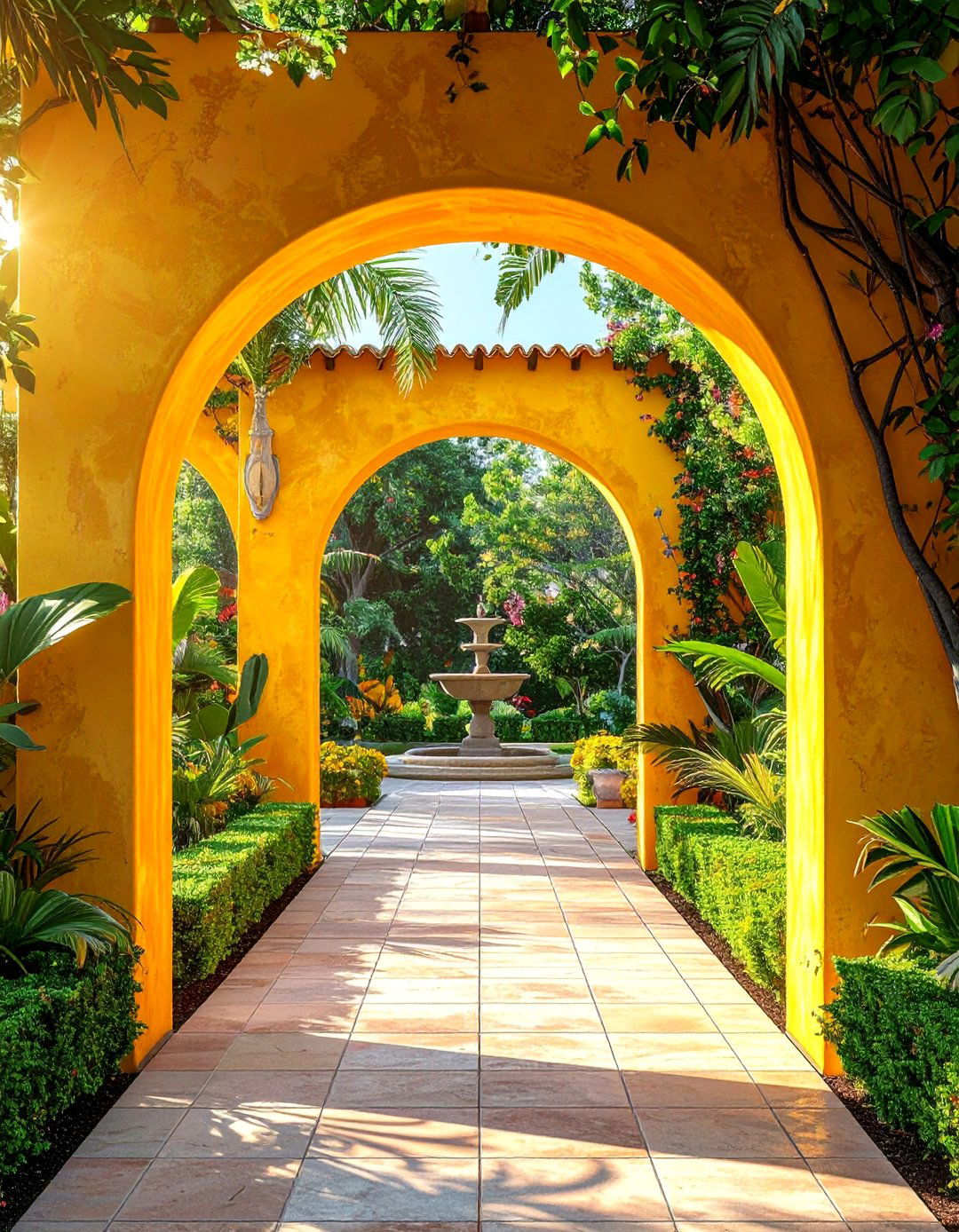
Incorporating a hacienda-style archway is a wonderful way to add architectural interest and create a sense of transition between different areas of your Mexican garden. A gracefully curved arch, constructed from stucco or stone, can frame a beautiful view, mark the entrance to a patio, or lead from a sunny courtyard to a shaded walkway. You can paint the arch in a bold, contrasting color or leave it in a natural, earthy tone. Planting a climbing vine like trumpet vine or jasmine to grow over the arch enhances its romantic appeal and integrates it beautifully into the surrounding landscape.
10. Vibrant Marigold Flower Beds in a Mexican Garden
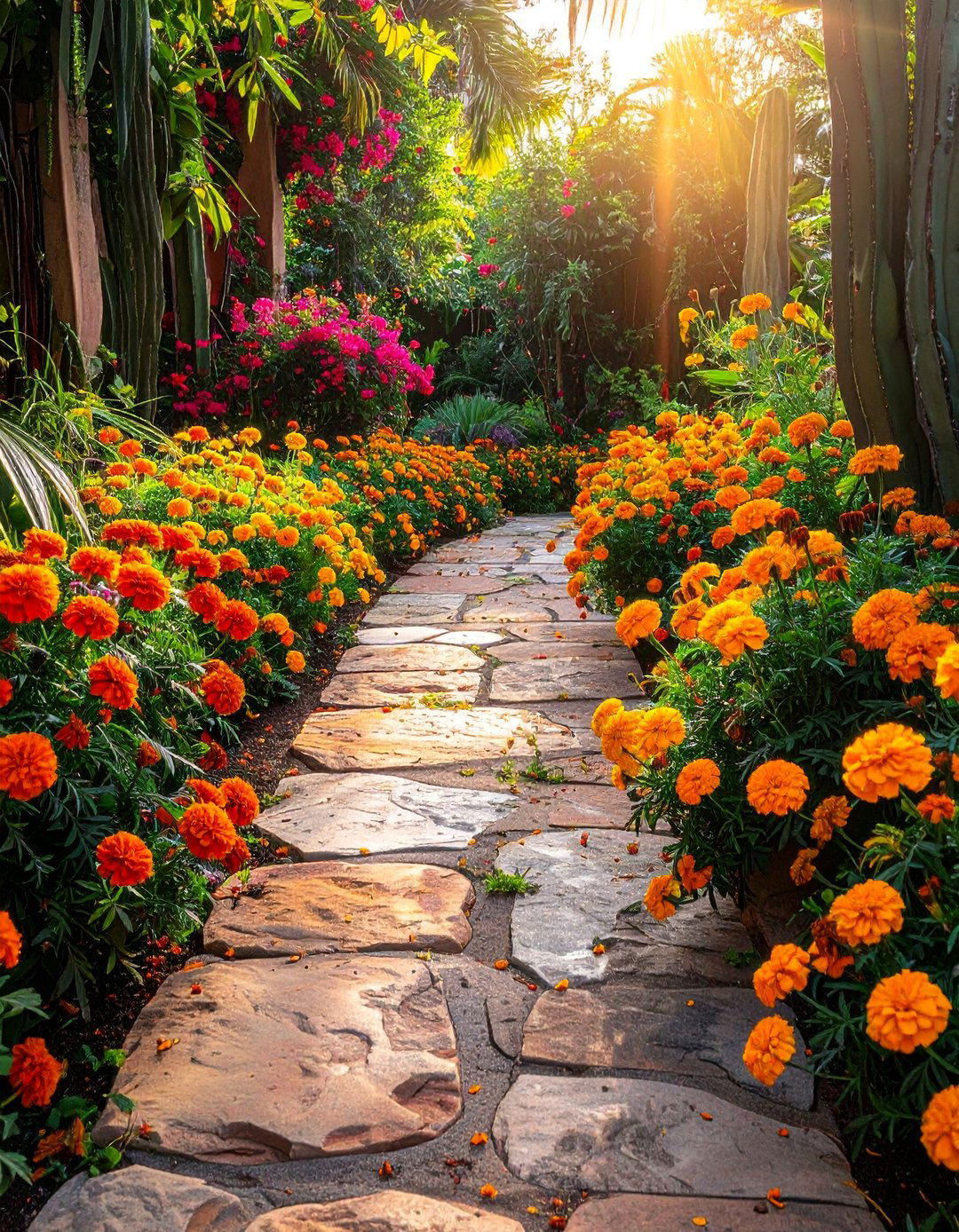
Marigolds, or "cempasúchil," hold deep cultural significance in Mexico and are a brilliant addition to any Mexican garden. Their cheerful, pom-pom-like flowers in shades of bright yellow and deep orange create a stunning visual impact when planted in dense beds or as borders along pathways. These hardy annuals thrive in full sun and bloom profusely, offering a continuous splash of warm color throughout the season. Their vibrant hue contrasts beautifully against cobalt blue walls or the deep green of cacti. Planting marigolds is an easy way to infuse your garden with authentic color and cultural symbolism.
11. An Agave as a Sculptural Focal Point in a Mexican Garden
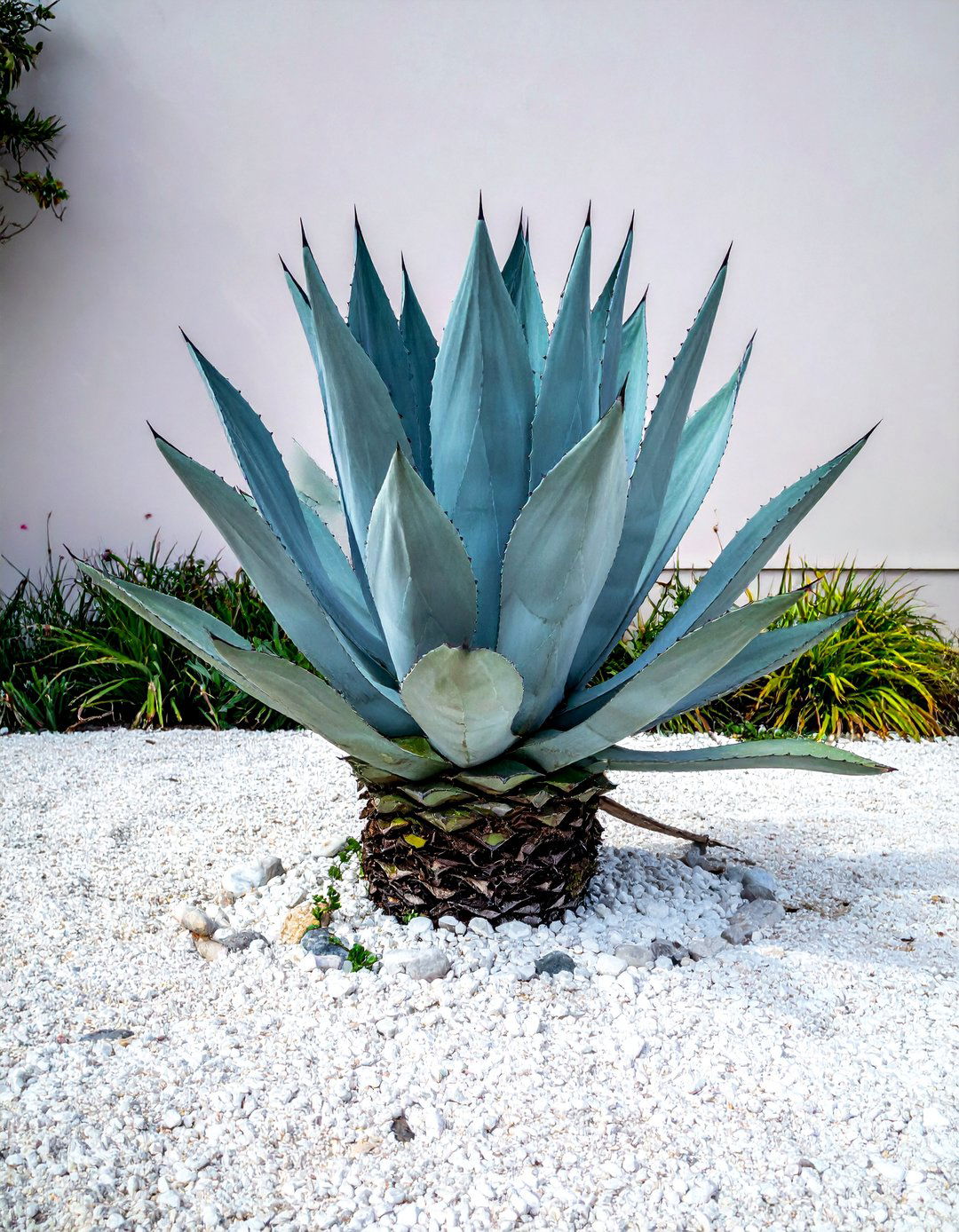
Using a large agave as a sculptural focal point provides a dramatic and architectural element that is central to Mexican garden design. The bold, symmetrical rosette of a Century Plant (Agave americana) or the striking form of a Whale's Tongue Agave (Agave ovatifolia) can anchor a planting bed or stand alone in a large container. Its strong lines and often blue-green or silvery foliage create a powerful visual statement that contrasts with softer surrounding plants. This low-maintenance succulent is not only drought-tolerant but also embodies the resilient and stunning beauty of the Mexican landscape, making it an ideal centerpiece.
12. An Outdoor Chiminea Fireplace in a Mexican Garden
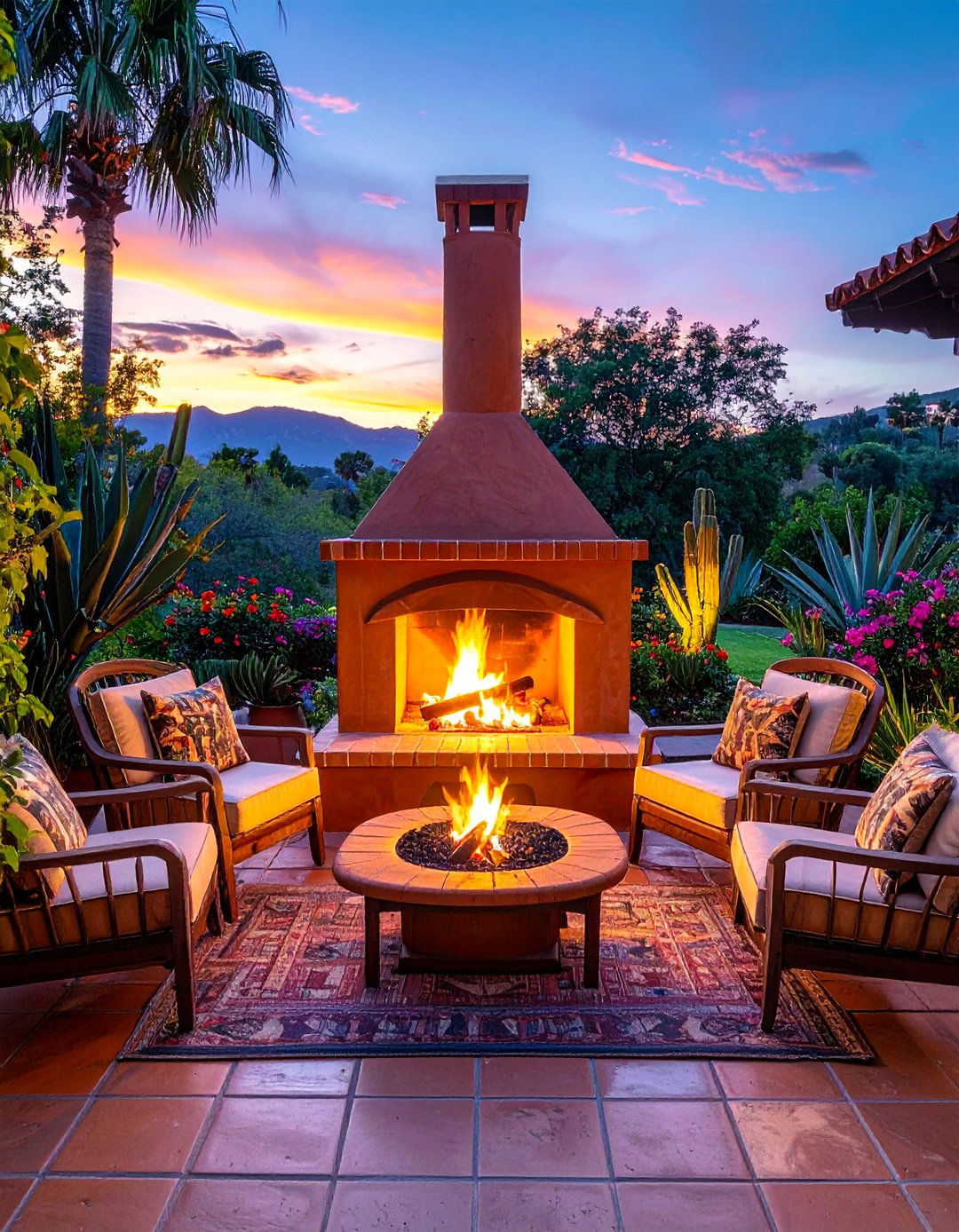
A traditional terracotta chiminea brings warmth, ambiance, and a classic focal point to a Mexican garden patio. These freestanding, front-loading outdoor fireplaces have a distinctive shape with a vertical smoke vent, efficiently directing smoke away from the seating area. The earthy clay material complements the garden's rustic aesthetic perfectly. A chiminea extends the usability of your outdoor space into cooler evenings, providing a cozy gathering spot for friends and family. Its gentle, crackling fire adds a magical glow, enhancing the enchanting and inviting atmosphere of your hacienda-inspired retreat after the sun sets.
13. A Colorful Hammock for a Mexican Garden Siesta
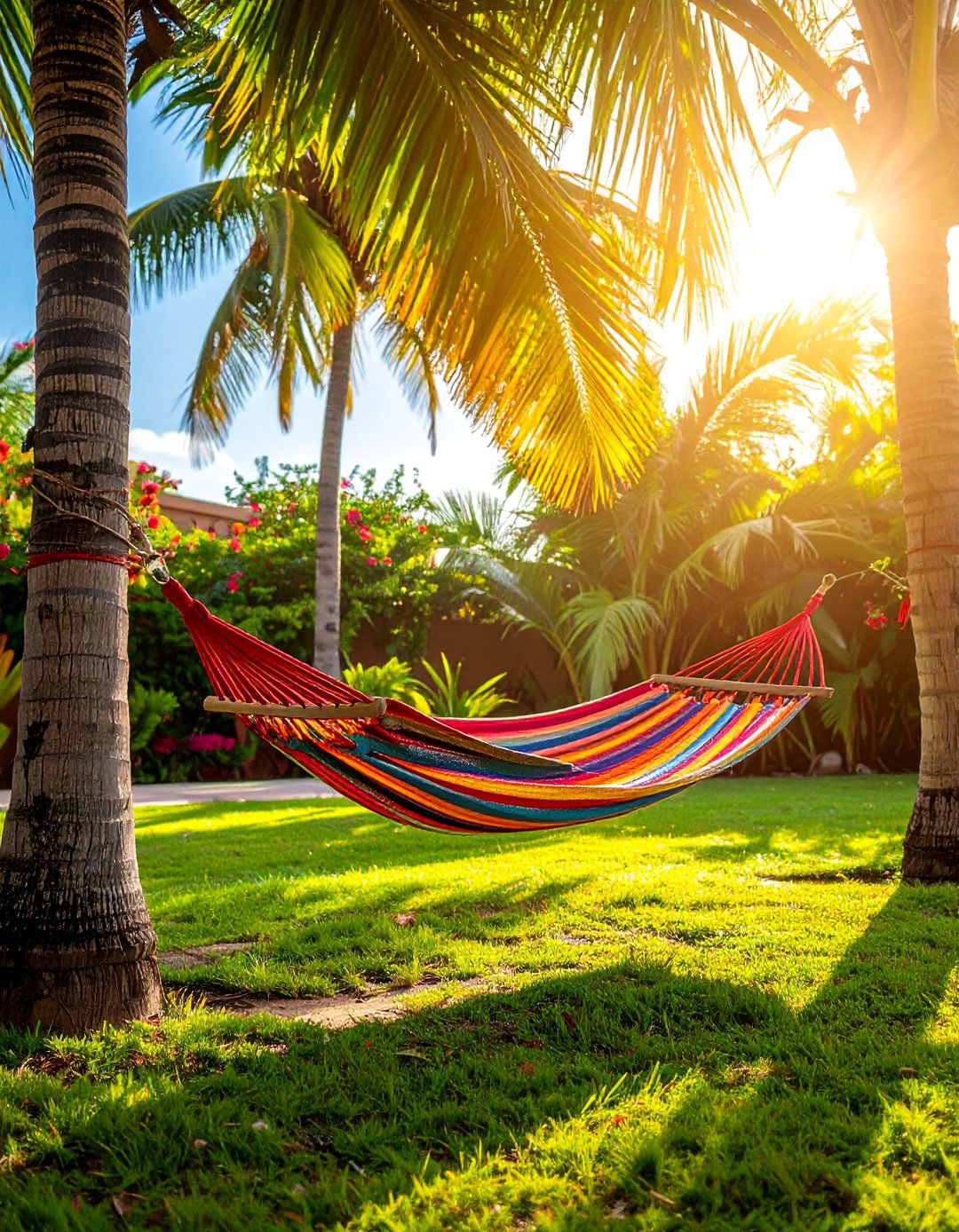
For the ultimate in relaxation, hang a colorful, hand-woven hammock in a shady corner of your Mexican garden. Woven in bright, festive stripes or a simple, natural fiber, a hammock epitomizes the leisurely pace of a siesta. Suspend it between two sturdy trees or from the posts of a pergola to create an irresistible spot for an afternoon nap or quiet reading. The gentle swaying motion and the vibrant textile add a touch of bohemian charm and functional comfort. Surrounded by lush foliage and the scent of flowers, a hammock becomes a personal oasis within your larger garden sanctuary.
14. A Shaded Patio with Viga Beams in a Mexican Garden
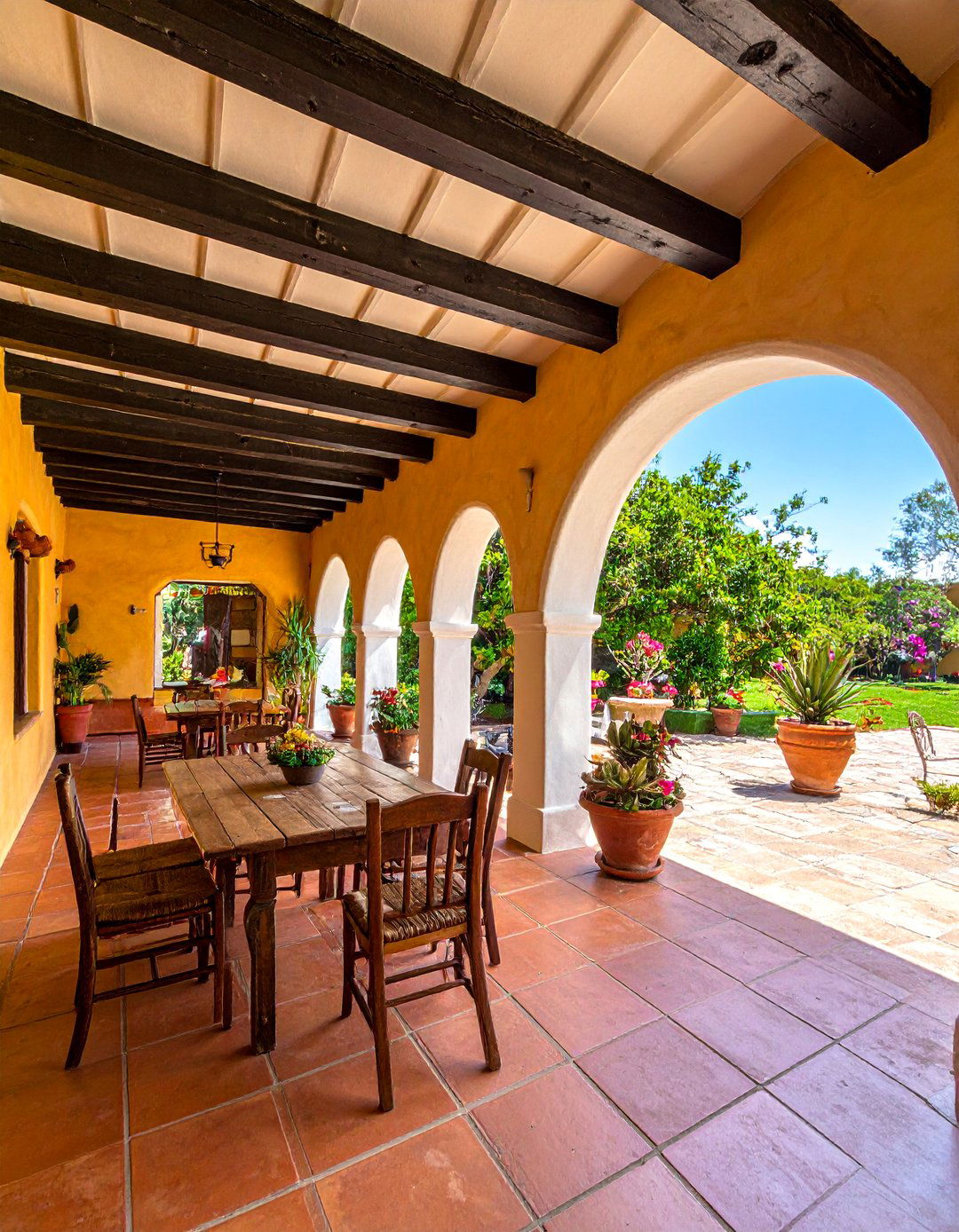
Creating a shaded patio with exposed wooden viga beams captures the authentic architectural style of a Mexican hacienda. These rustic, rounded logs span the ceiling of a covered patio or ramada, providing both structural support and a strong visual element. The dark, natural wood contrasts beautifully with light-colored stucco walls and a Saltillo tile floor. This overhead structure provides essential relief from the hot sun, creating a comfortable outdoor living area for dining or lounging. Adorn the space with wrought iron furniture and colorful cushions to complete the inviting, rustic look.
15. Natural Stone Pathways in a Mexican Garden
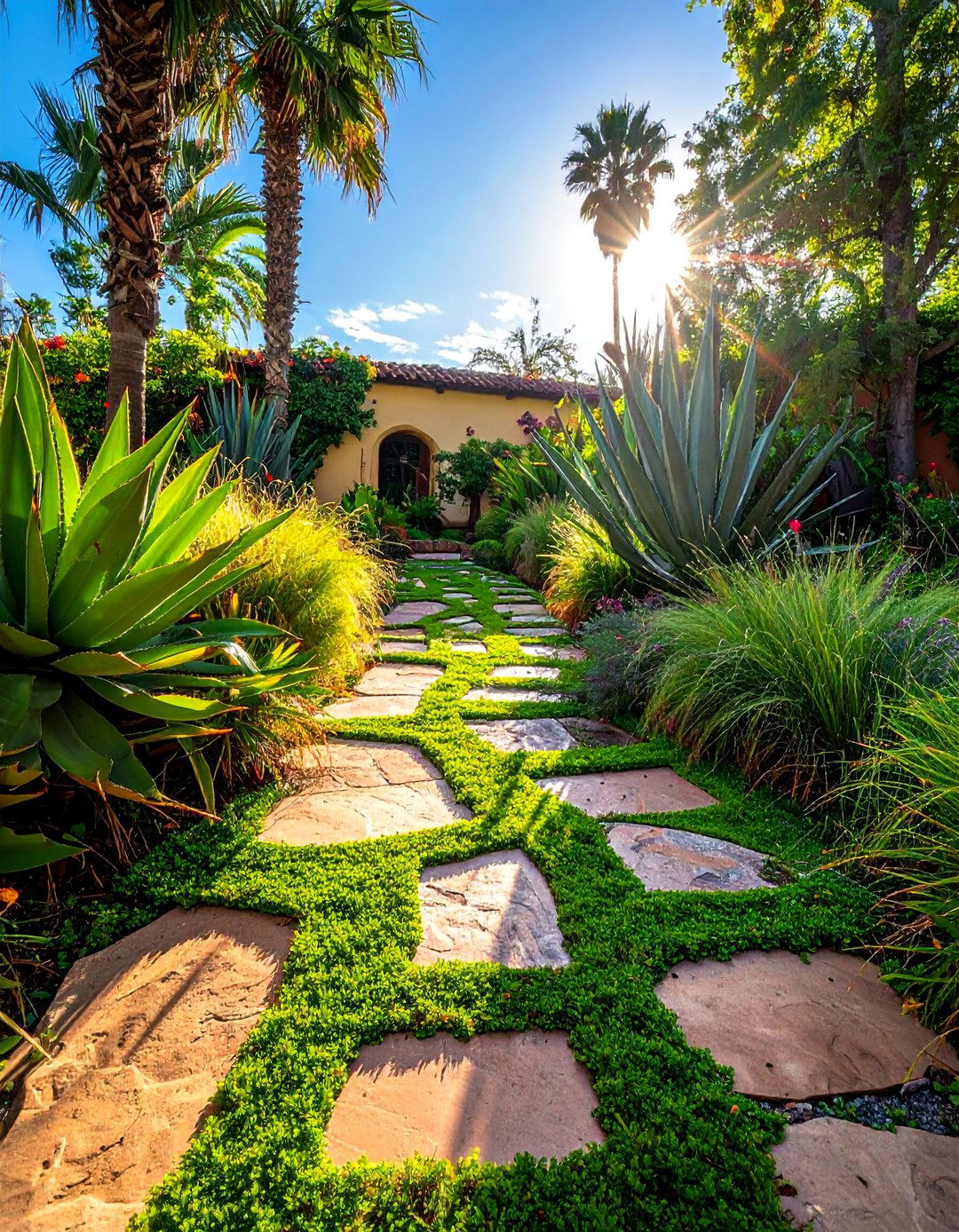
Winding stone pathways are a fundamental element for adding rustic texture and guiding movement through a Mexican garden. Using locally sourced flagstone or river rocks to create an informal path enhances the naturalistic feel of the space. The irregular shapes and earthy tones of the stones blend seamlessly with drought-tolerant plantings like succulents and ornamental grasses. Setting the stones with wider gaps allows hardy groundcovers like thyme or creeping sedum to grow between them, softening the look. These pathways not only provide practical access but also contribute to the garden's overall organic and time-worn charm.
16. Using Saltillo Tile Flooring in a Mexican Garden
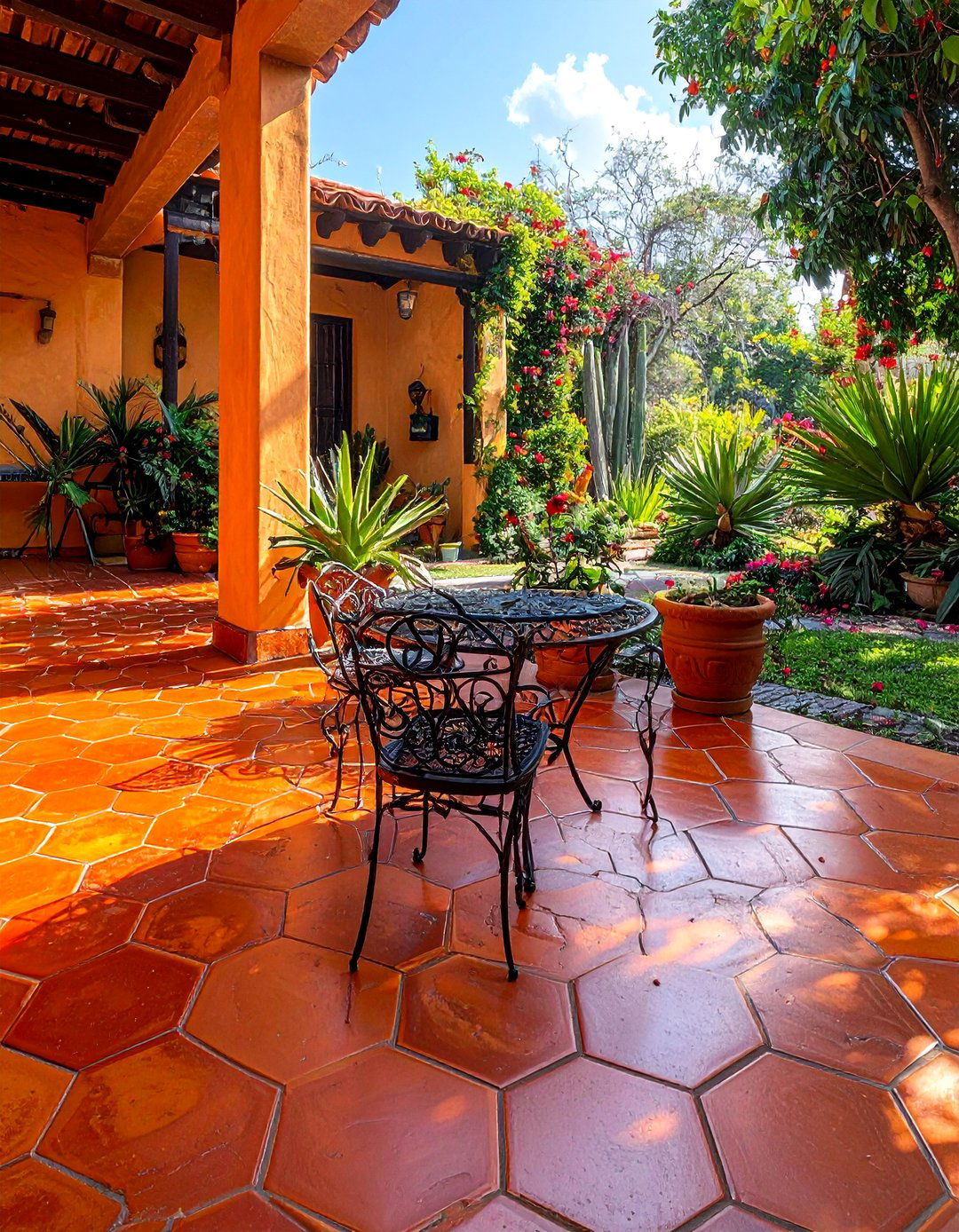
Saltillo tile is a classic choice for paving patios, courtyards, and walkways in a Mexican garden, lending an authentic, sun-baked warmth to the space. These handmade terracotta tiles, known for their rustic imperfections and variations in color from deep orange to yellow and cream, create a floor that is full of character. Their earthy hue serves as a perfect foundation, complementing vibrant wall colors and the green tones of surrounding plants. Whether arranged in a simple running bond or a more intricate pattern, Saltillo tiles provide a durable and beautiful surface that feels cool underfoot and ages gracefully over time.
17. A Wall Niche for Art in a Mexican Garden
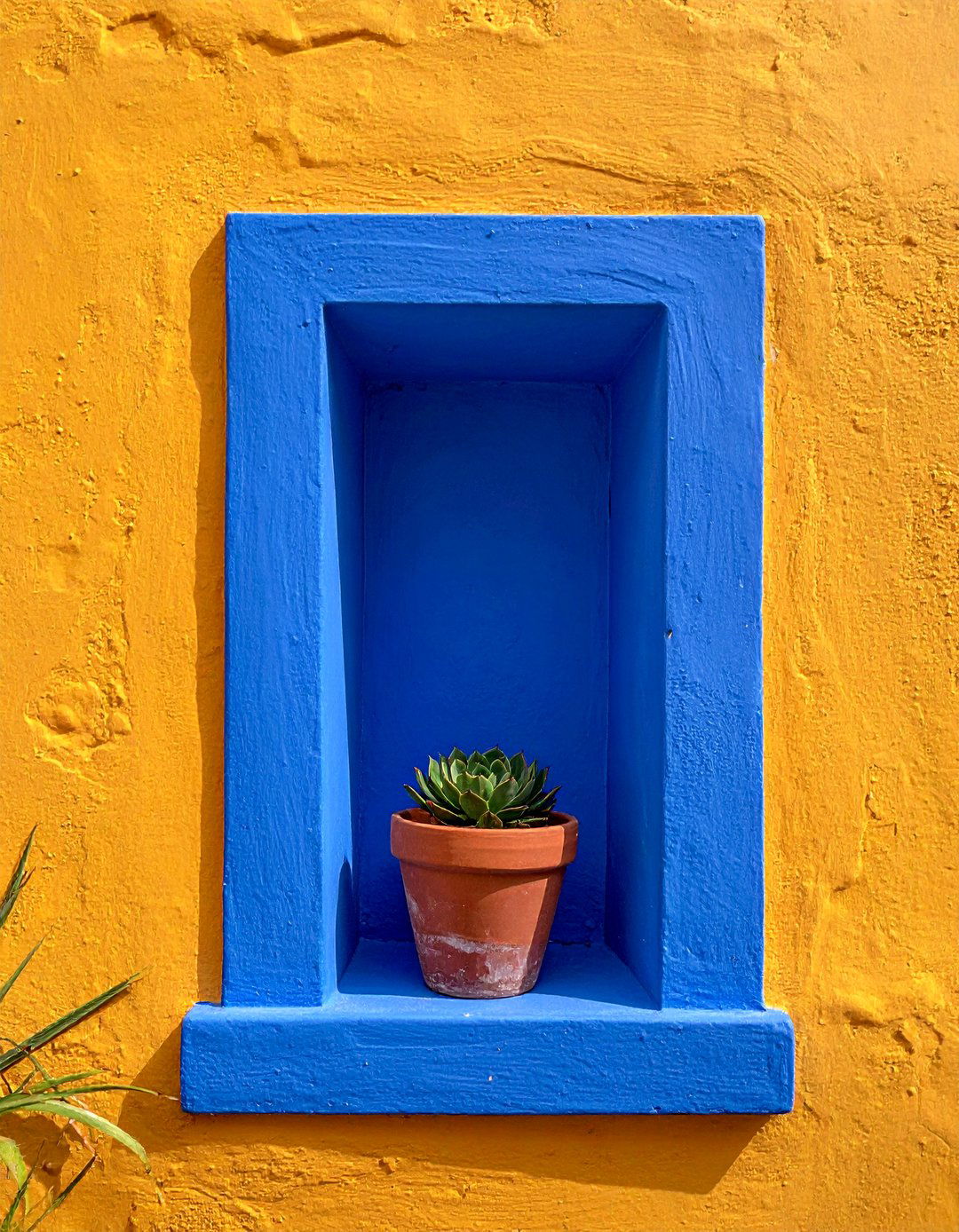
Incorporating a recessed wall niche, or "nicho," is a distinctive architectural detail that adds depth and a place for personal expression in a Mexican garden. These small alcoves, built directly into a stucco wall, are traditionally used to display religious icons, small sculptures, or a single beautiful potted plant. You can paint the inside of the niche a contrasting, vibrant color to draw attention to the object within or adorn its edges with decorative Talavera tiles. This simple feature adds a touch of custom artistry and a focal point of quiet contemplation to an otherwise flat wall surface.
18. An Outdoor Kitchen with a Cob Oven in a Mexican Garden
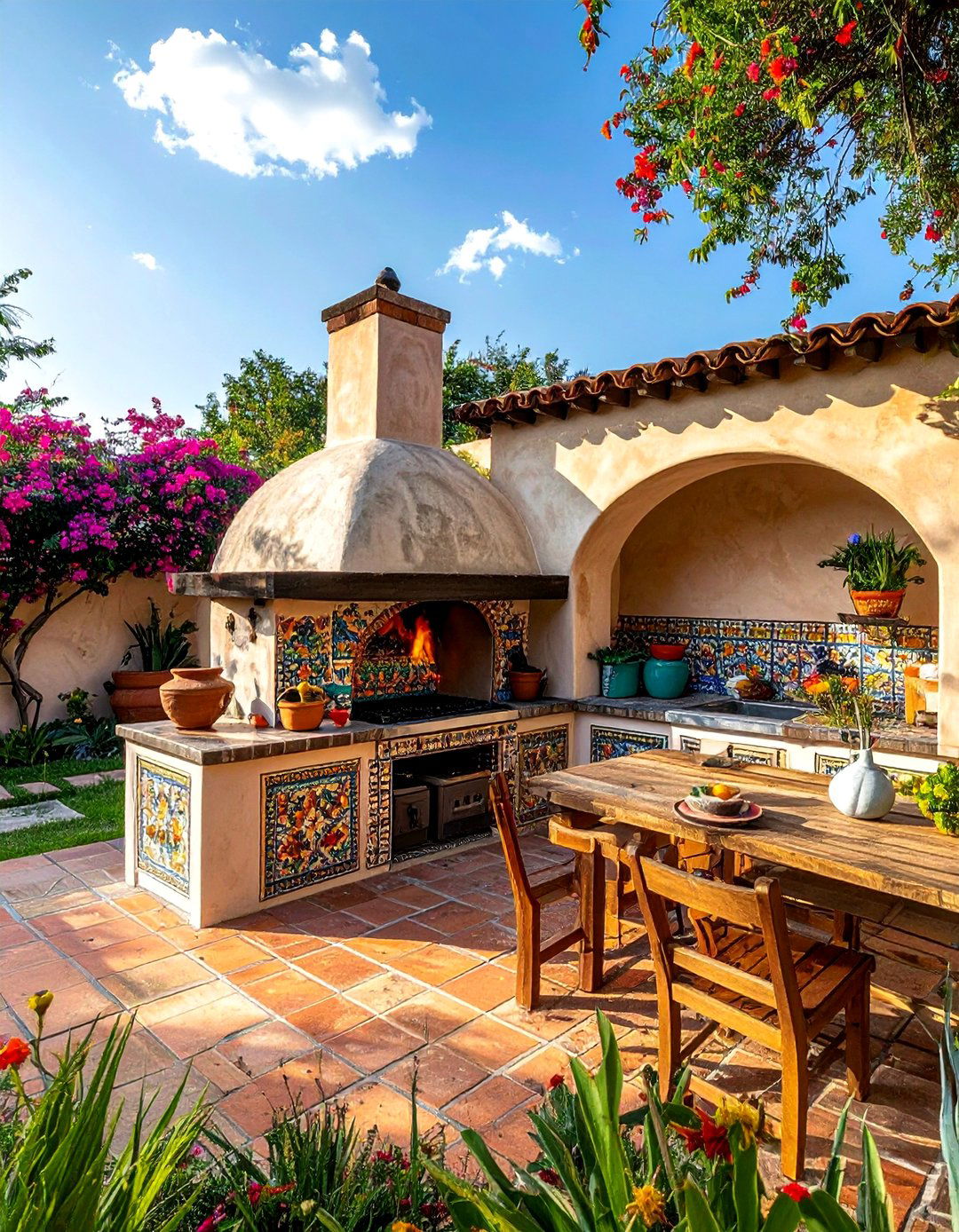
An outdoor kitchen designed with a traditional cob oven becomes the heart of entertaining in a Mexican garden. A cob oven, made from a mixture of clay, sand, and straw, is perfect for baking pizzas or rustic breads and adds an authentic, sculptural element to the patio. Surround the oven with countertops finished in colorful Talavera or smooth concrete. This functional space encourages alfresco dining and social gatherings, blending seamlessly with the garden’s rustic aesthetic. Pair it with a sturdy wooden dining table and wrought iron chairs to create the ultimate outdoor destination for cooking and enjoying meals with loved ones.
19. A Dry Creek Bed in a Mexican Garden
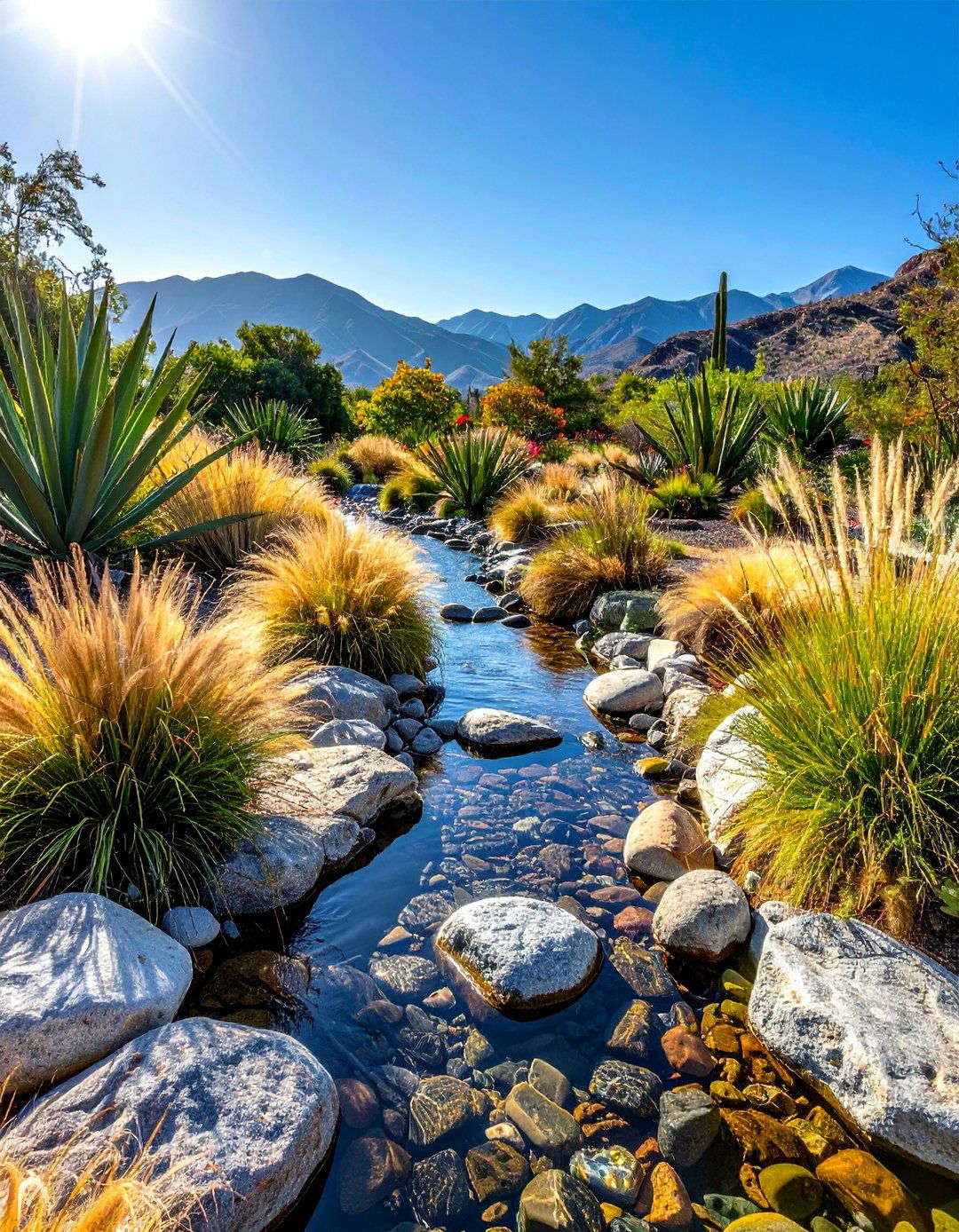
Creating a dry creek bed, or "arroyo seco," is a visually appealing and water-wise feature for a Mexican garden. This design element uses a variety of river rocks, pebbles, and small boulders to mimic the appearance of a natural, seasonal stream. It's an excellent solution for managing drainage in your yard and adds texture and interest to the landscape. Plant the edges with drought-tolerant plants like agaves, yuccas, and ornamental grasses to enhance the naturalistic effect. The winding path of the stones draws the eye through the garden, creating a sense of movement and capturing the rugged beauty of an arid landscape.
20. Colorful Painted Furniture in a Mexican Garden
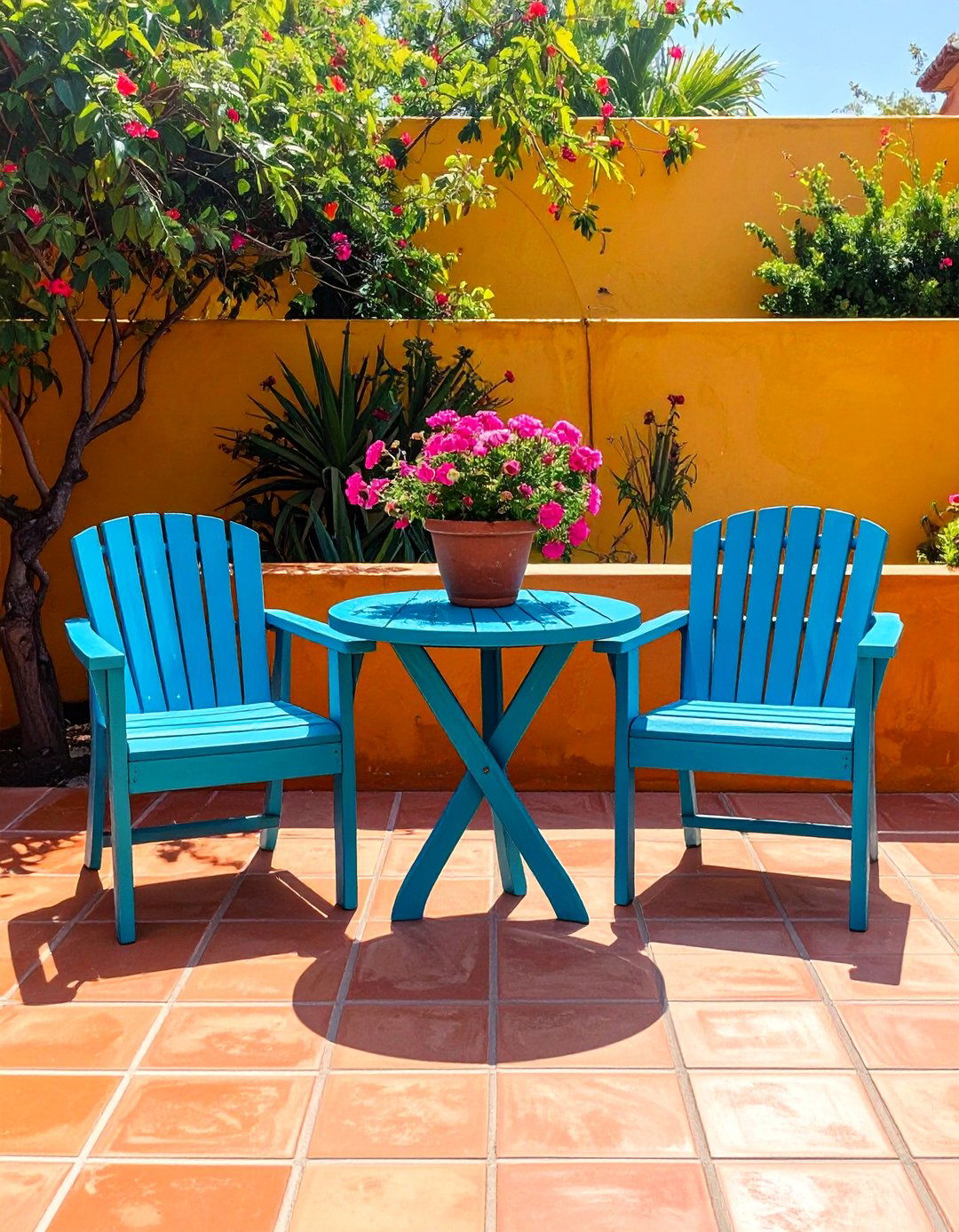
Beyond rustic wood, brightly painted furniture can inject a playful and festive spirit into your Mexican garden. Take a simple wooden table and chair set and transform it with a coat of paint in a cheerful turquoise, sunny yellow, or vibrant watermelon pink. This is an easy and affordable way to add a splash of personality and coordinate with the colors of your flowering plants or painted walls. The cheerful furniture provides a lively spot for morning coffee or casual outdoor meals, contributing to the garden's overall atmosphere of joyful celebration and vibrant energy, making every day feel like a fiesta.
21. Creating Privacy with Stucco Walls in a Mexican Garden
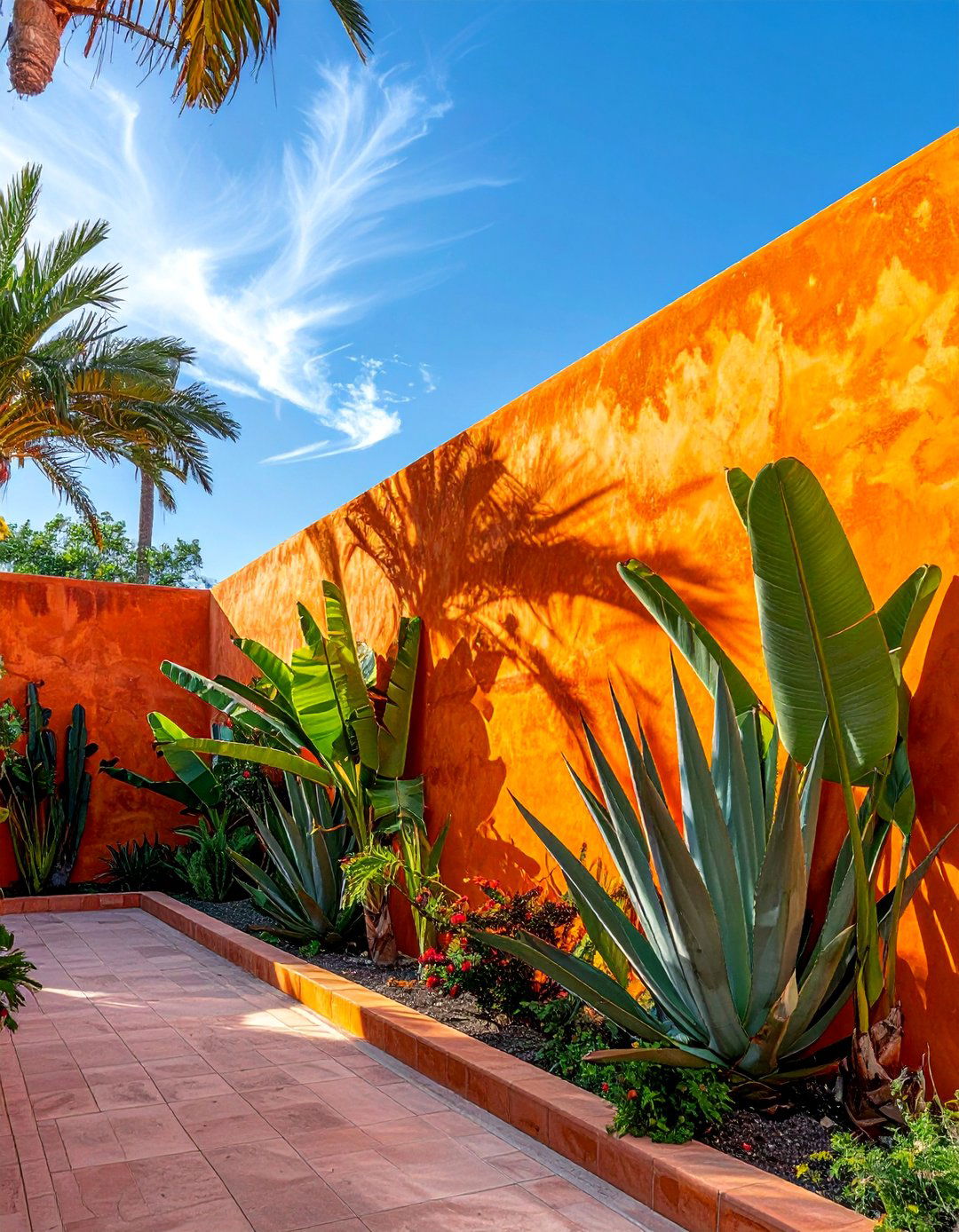
High stucco walls are a defining feature of Mexican garden architecture, providing a sense of privacy and enclosure that creates a true outdoor room. These walls, finished with a textured plaster, serve as the perfect canvas for showcasing bold colors like terracotta orange, brilliant blue, or warm yellow. They also offer a clean backdrop that makes the shapes of cacti and the colors of flowers stand out dramatically. Beyond their aesthetic appeal, stucco walls absorb the sun's heat during the day and radiate it back in the cool evenings, helping to moderate the temperature within your secluded garden sanctuary.
22. Using Ornamental Grasses in a Mexican Garden
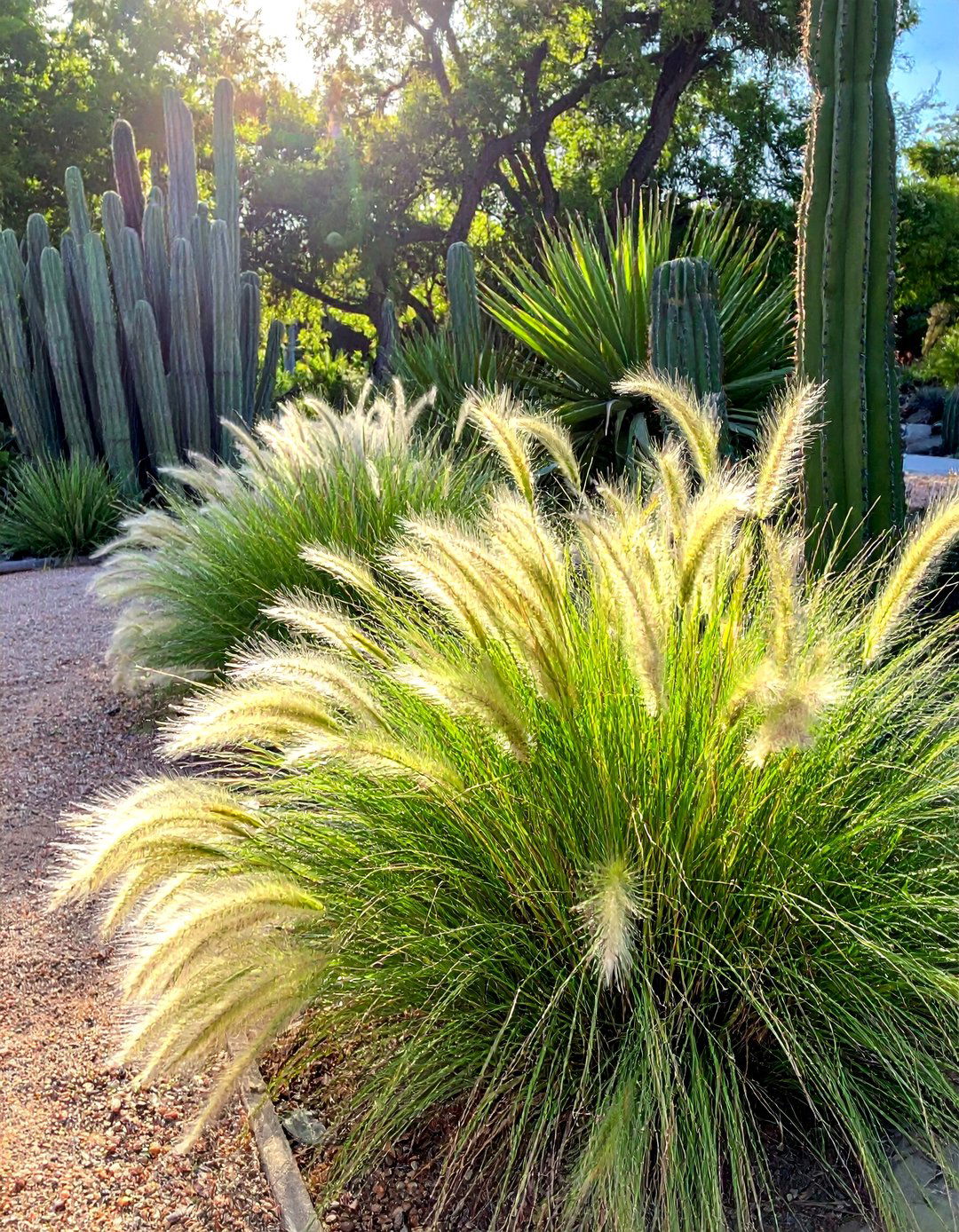
While cacti and succulents are staples, incorporating ornamental grasses adds softness, movement, and texture to a Mexican garden. Varieties like Mexican Feather Grass (Nassella tenuissima) with its fine, flowing blades, or Pink Muhly Grass (Muhlenbergia capillaris) with its airy pink plumes, create a beautiful contrast to the rigid, sculptural forms of agaves and yuccas. These grasses are typically drought-tolerant and low-maintenance, swaying gently in the breeze to bring a dynamic quality to the landscape. They help to soften the hardscape elements and fill in spaces between larger plants with delicate, graceful texture.
23. A Tiered Herb Garden in a Mexican Garden
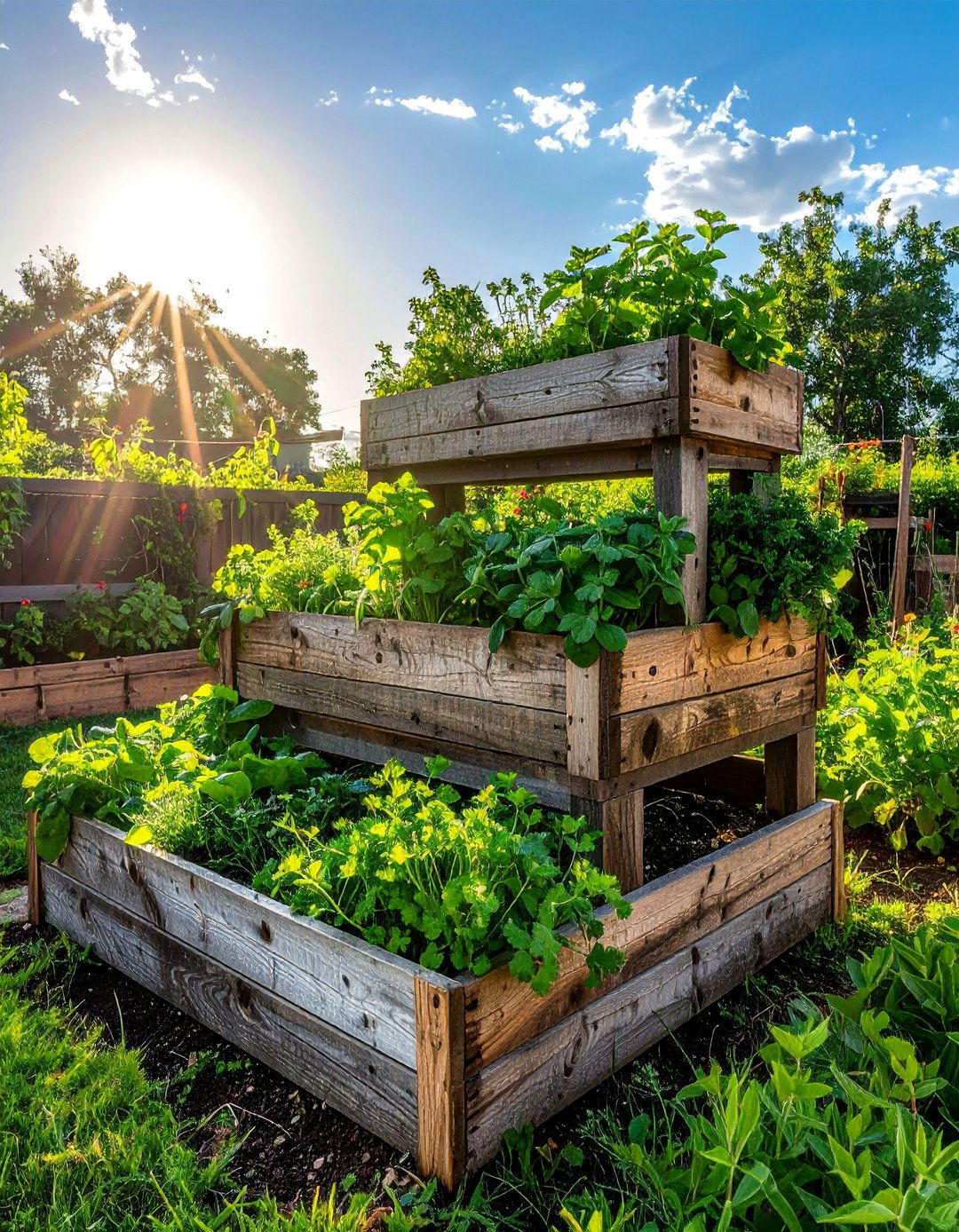
A tiered herb garden is a practical and beautiful addition to any Mexican garden, perfect for growing culinary staples like cilantro, oregano, mint, and epazote. You can build the tiers using rustic materials like reclaimed wood, stone, or even colorful cinder blocks. Placing it in a sunny spot near the kitchen makes it easy to harvest fresh herbs for cooking. The varying levels add visual interest and dimension to a small space, while the fragrant foliage contributes to the sensory experience of the garden. This feature combines functionality with the rustic, handmade aesthetic that is central to Mexican design.
24. A Classic Saltillo Tile Patio in a Mexican Garden
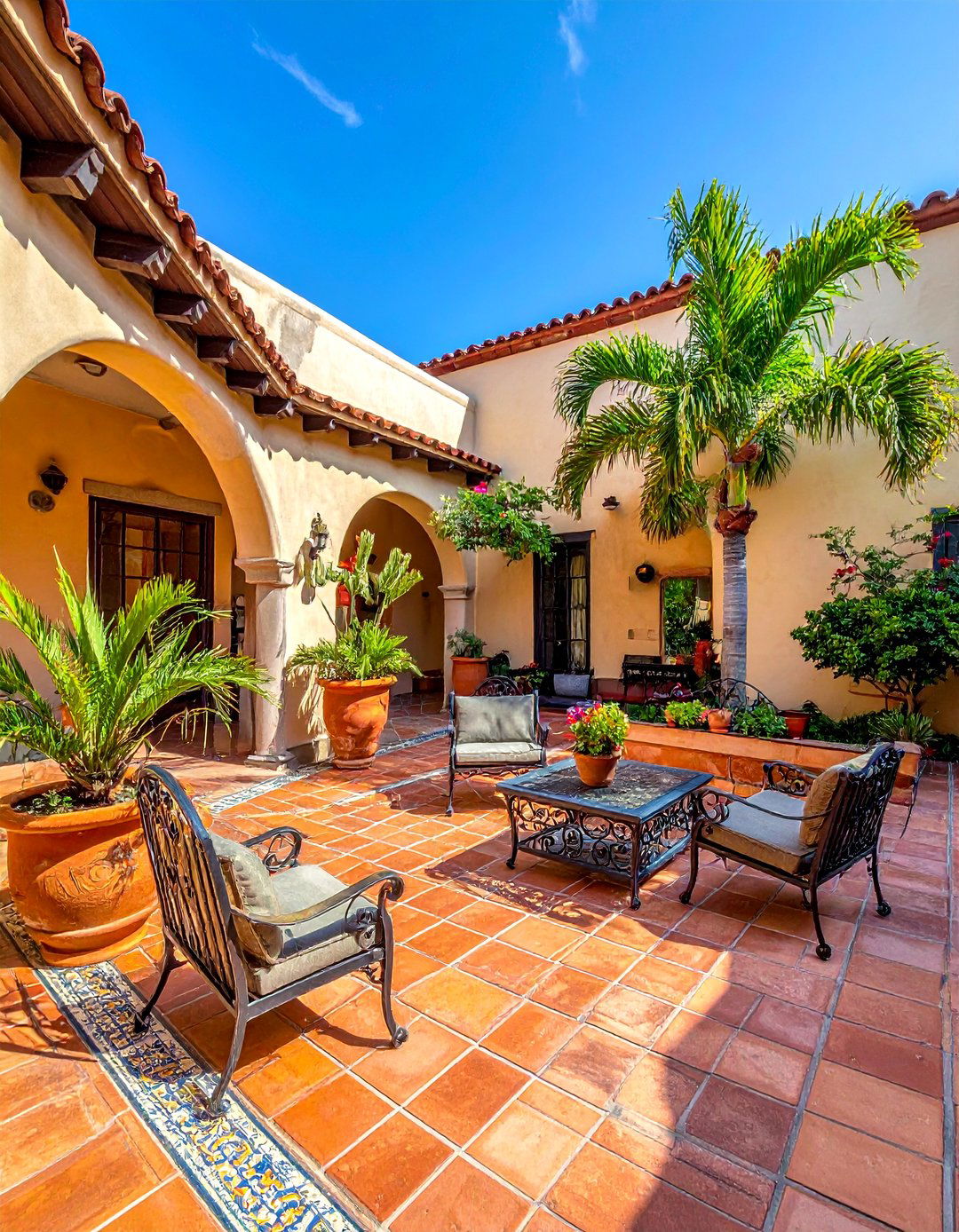
A spacious patio paved with classic Saltillo tiles creates the perfect foundation for an outdoor living area in a Mexican garden. These rustic, handmade clay tiles, with their characteristic warmth and color variations, establish an authentic hacienda feel. Arrange comfortable wrought iron furniture with colorful cushions and place large terracotta pots filled with vibrant flowers and succulents around the perimeter. A Saltillo tile patio is durable and feels cool underfoot, making it an ideal surface for dining, entertaining, or simply relaxing. It serves as a seamless transition from the home into the vibrant beauty of the garden.
25. Adding Papel Picado Banners in a Mexican Garden
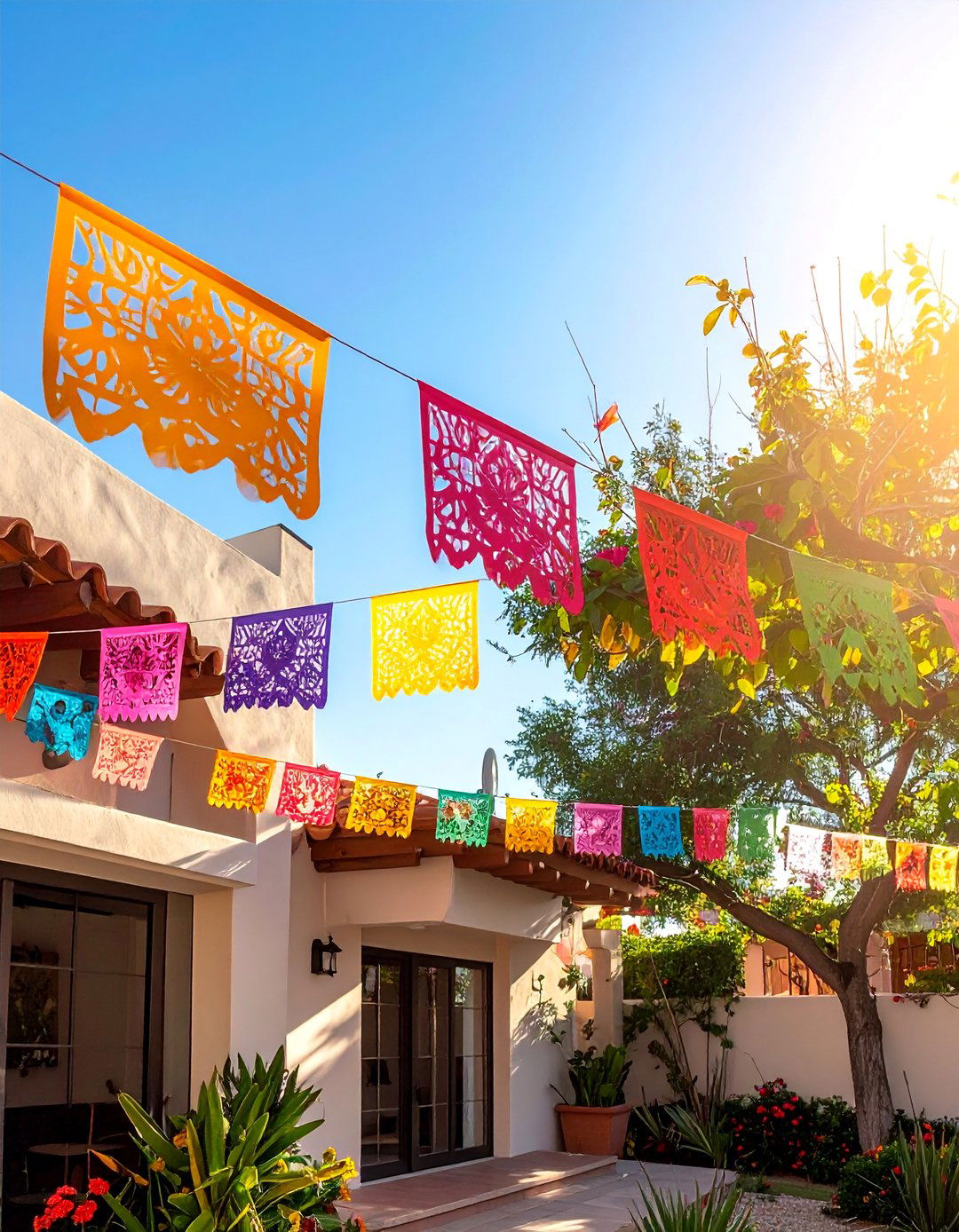
For a touch of festive flair, hang strings of colorful Papel Picado banners in your Mexican garden. These traditional Mexican folk art banners, made from intricately cut tissue paper, feature elaborate designs and are often used for celebrations. While paper versions are great for parties, you can find more durable plastic versions for long-term outdoor use. Strung between trees, across a patio, or along a pergola, they add vibrant color and joyful movement as they dance in the breeze. This simple addition instantly infuses the space with a celebratory spirit, making your garden feel ready for a fiesta at any moment.
Conclusion:
Creating a vibrant Mexican garden is an exercise in celebrating color, texture, and rustic beauty. By integrating key elements like bold stucco walls, intricate Talavera tiles, sculptural succulents, and the serene sound of a stone fountain, you can design a space that feels both exhilarating and tranquil. Whether you choose to incorporate a bougainvillea-draped pergola or a cozy chiminea for cool evenings, the goal is to craft an inviting outdoor retreat. This style transforms your backyard into a personal hacienda, a sun-drenched sanctuary perfect for relaxation and lively gatherings, reflecting a rich cultural heritage.

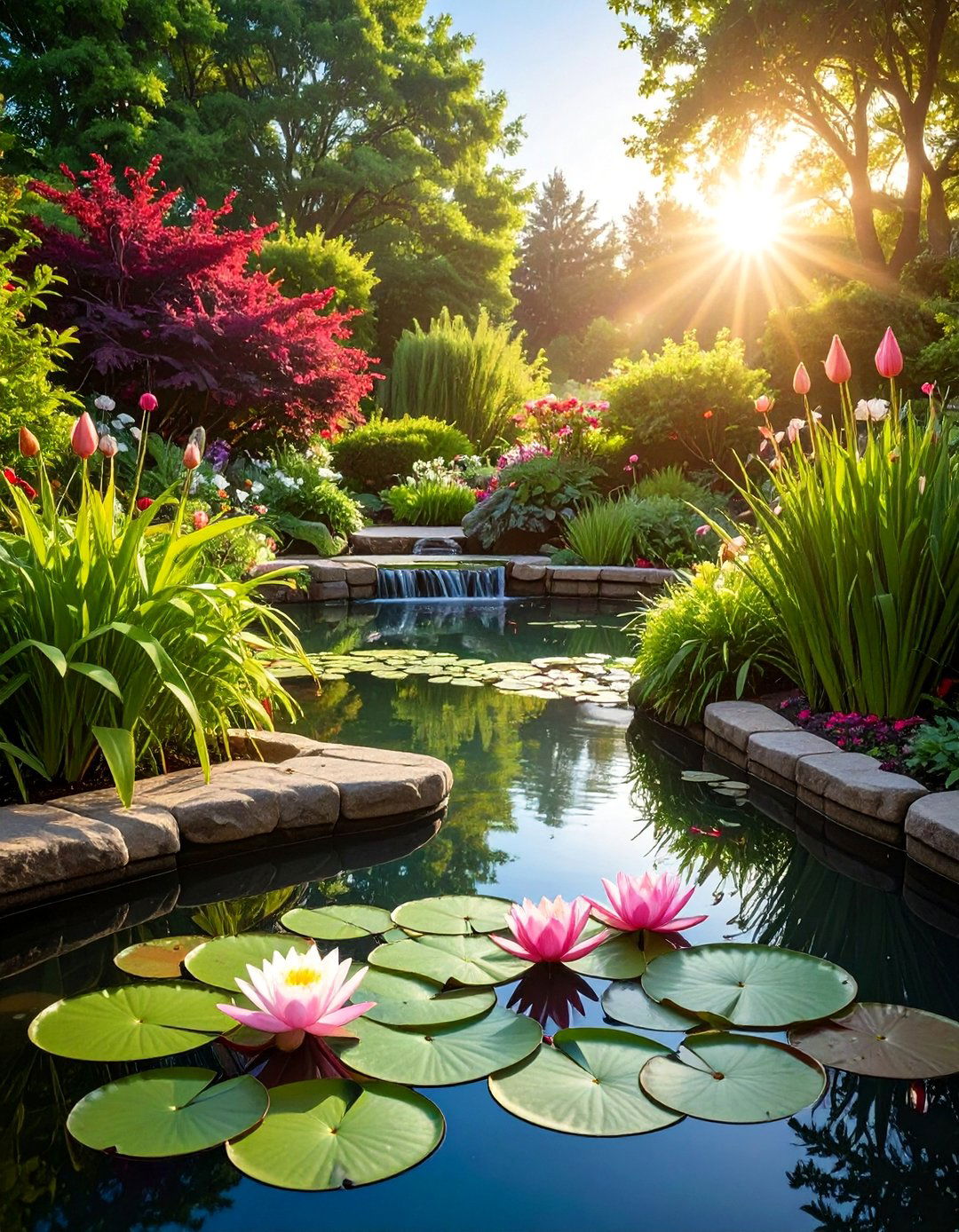
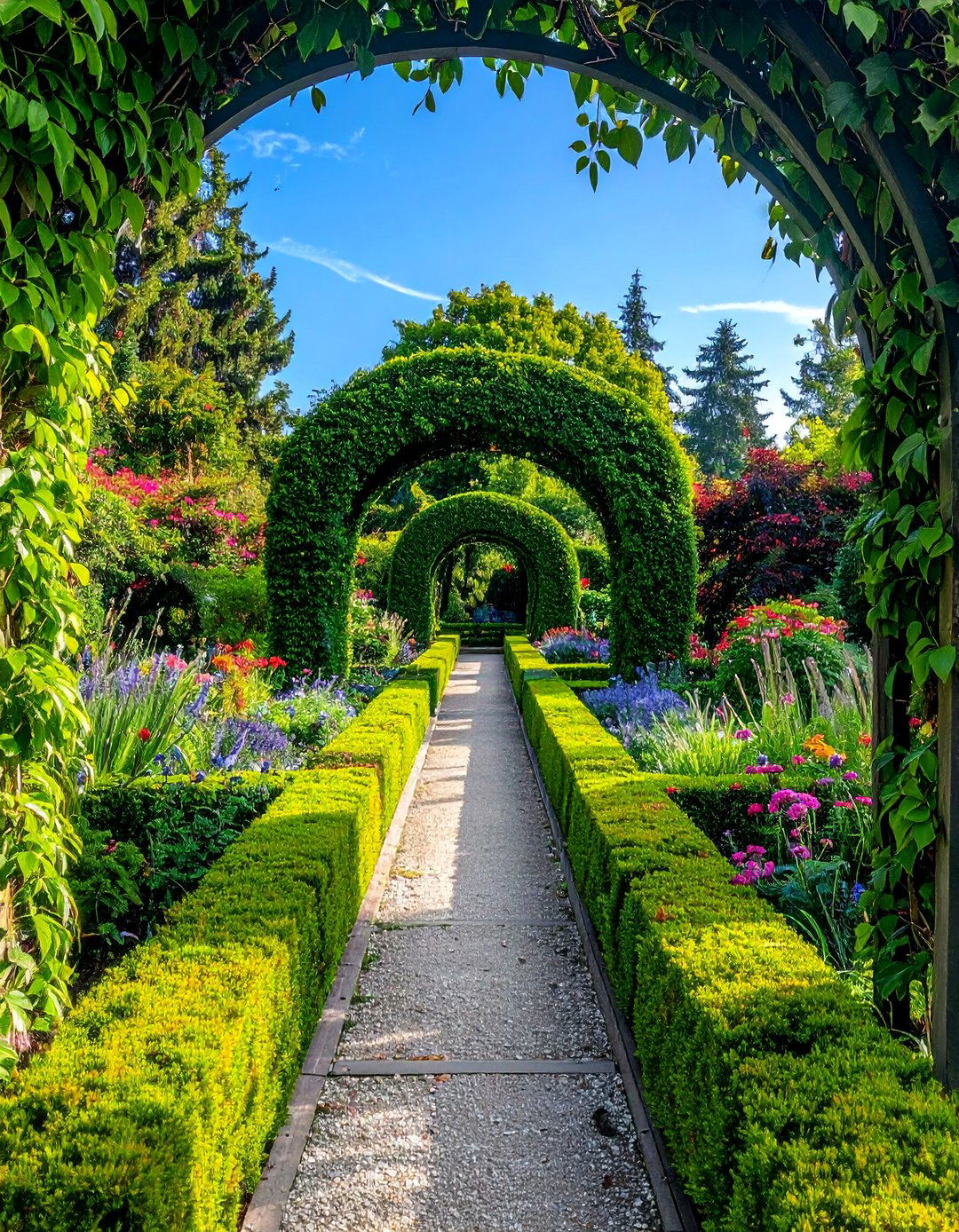
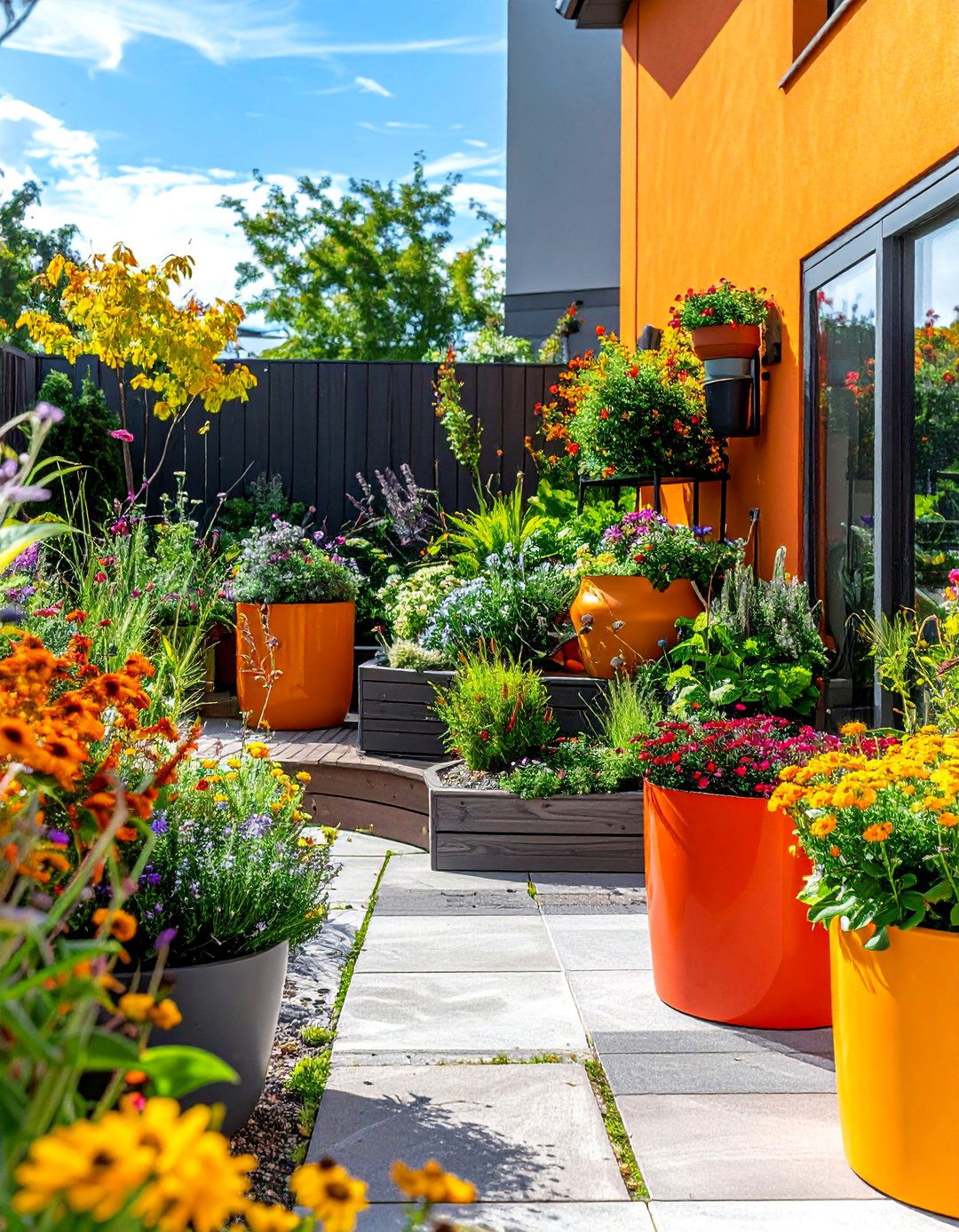
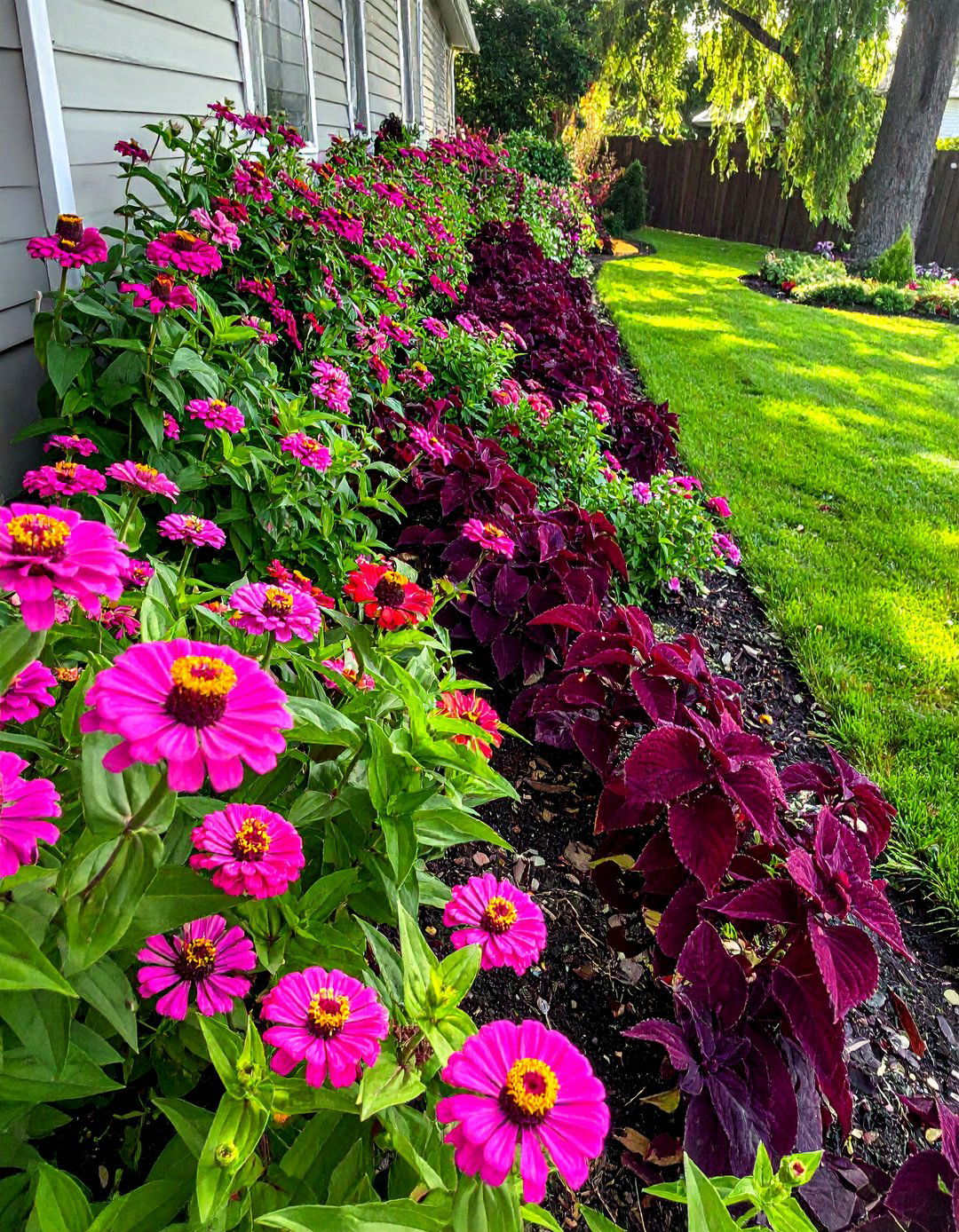
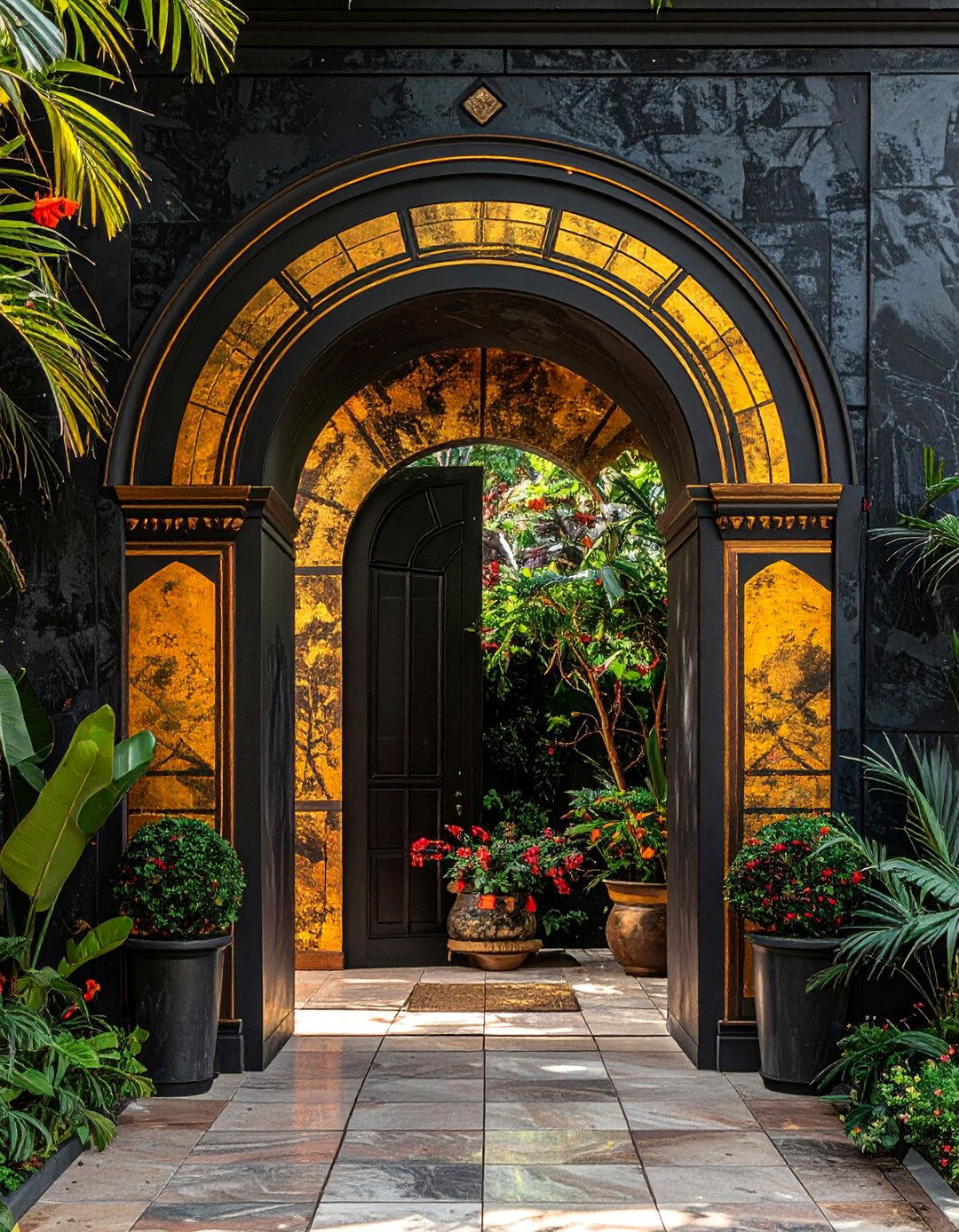
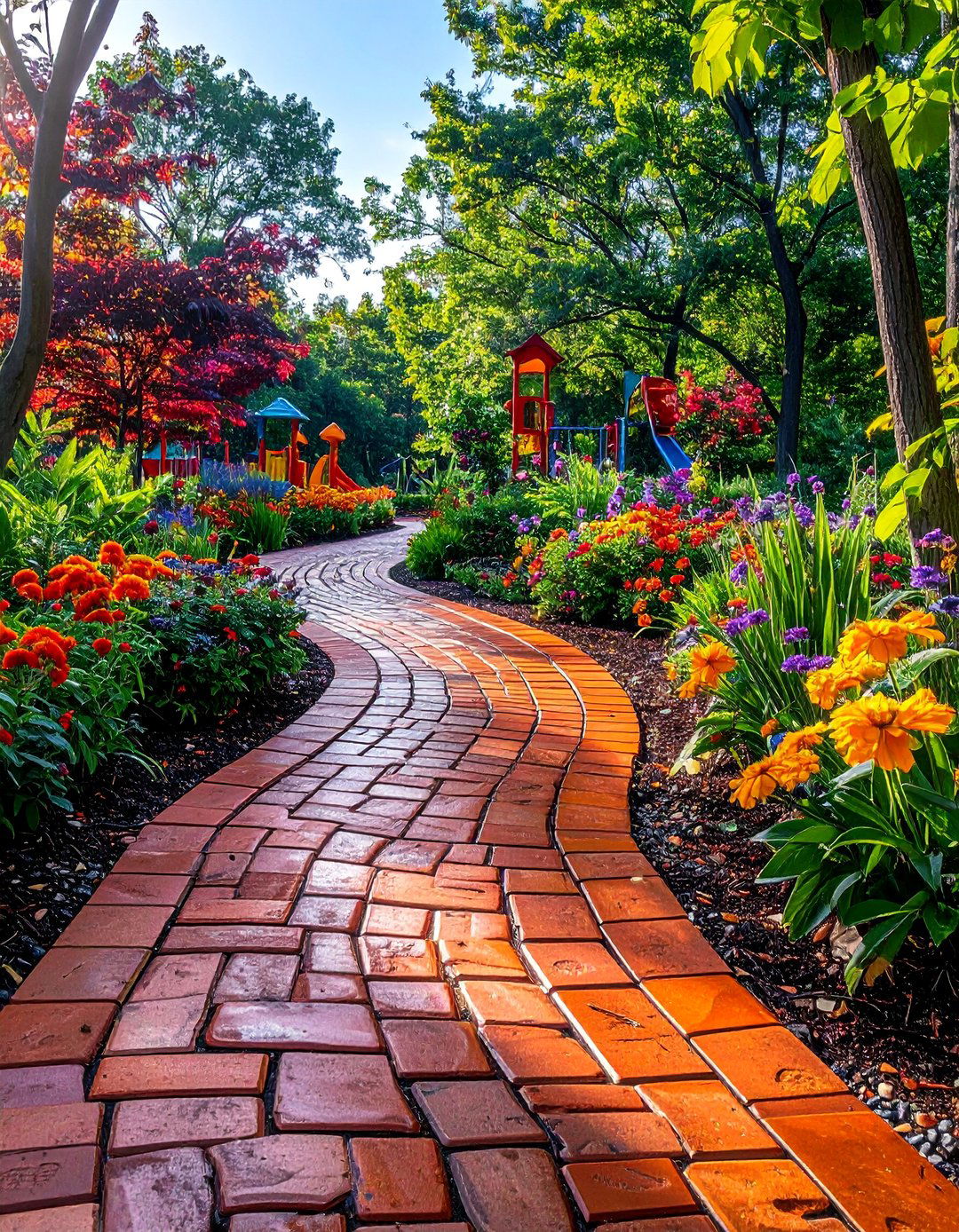
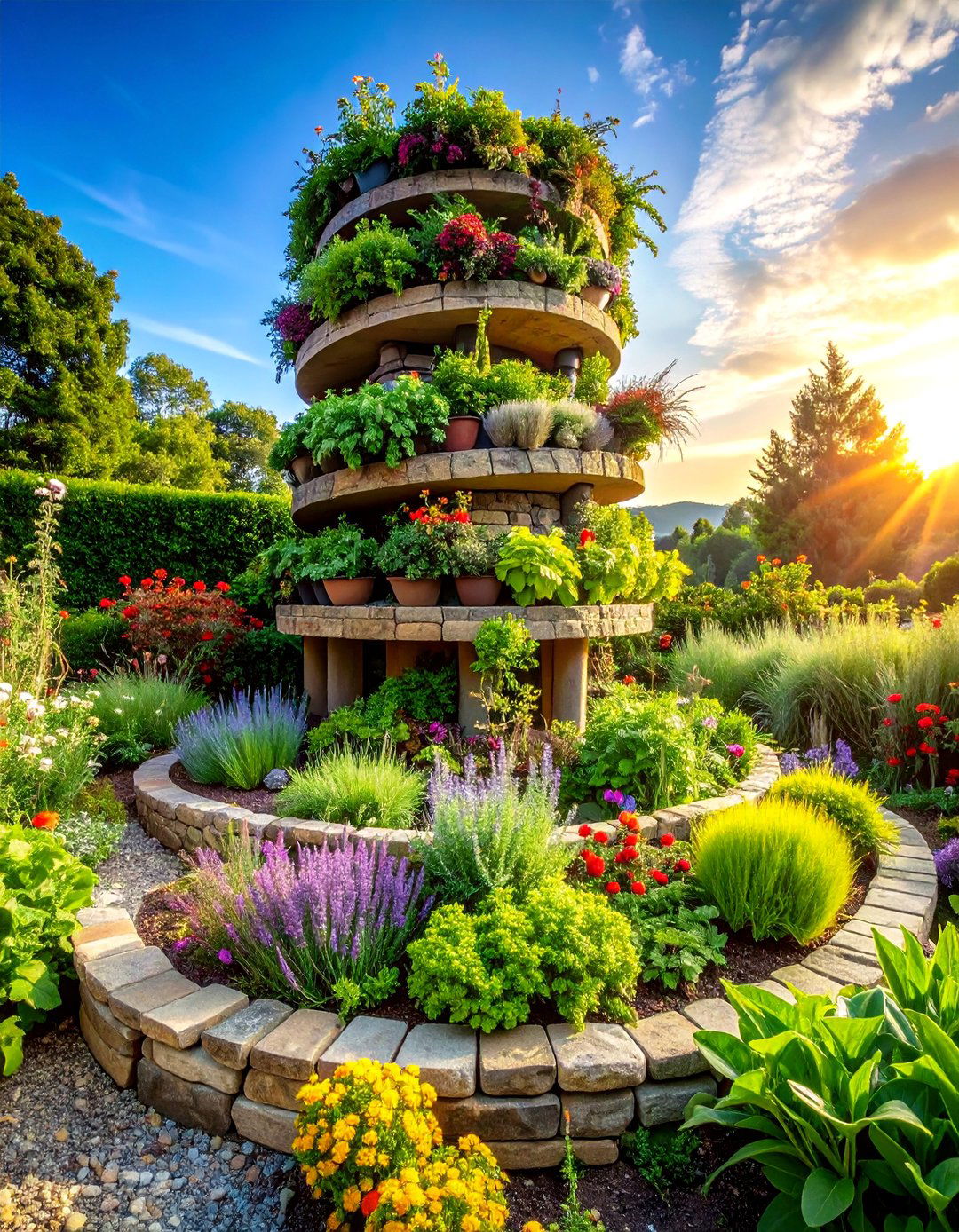
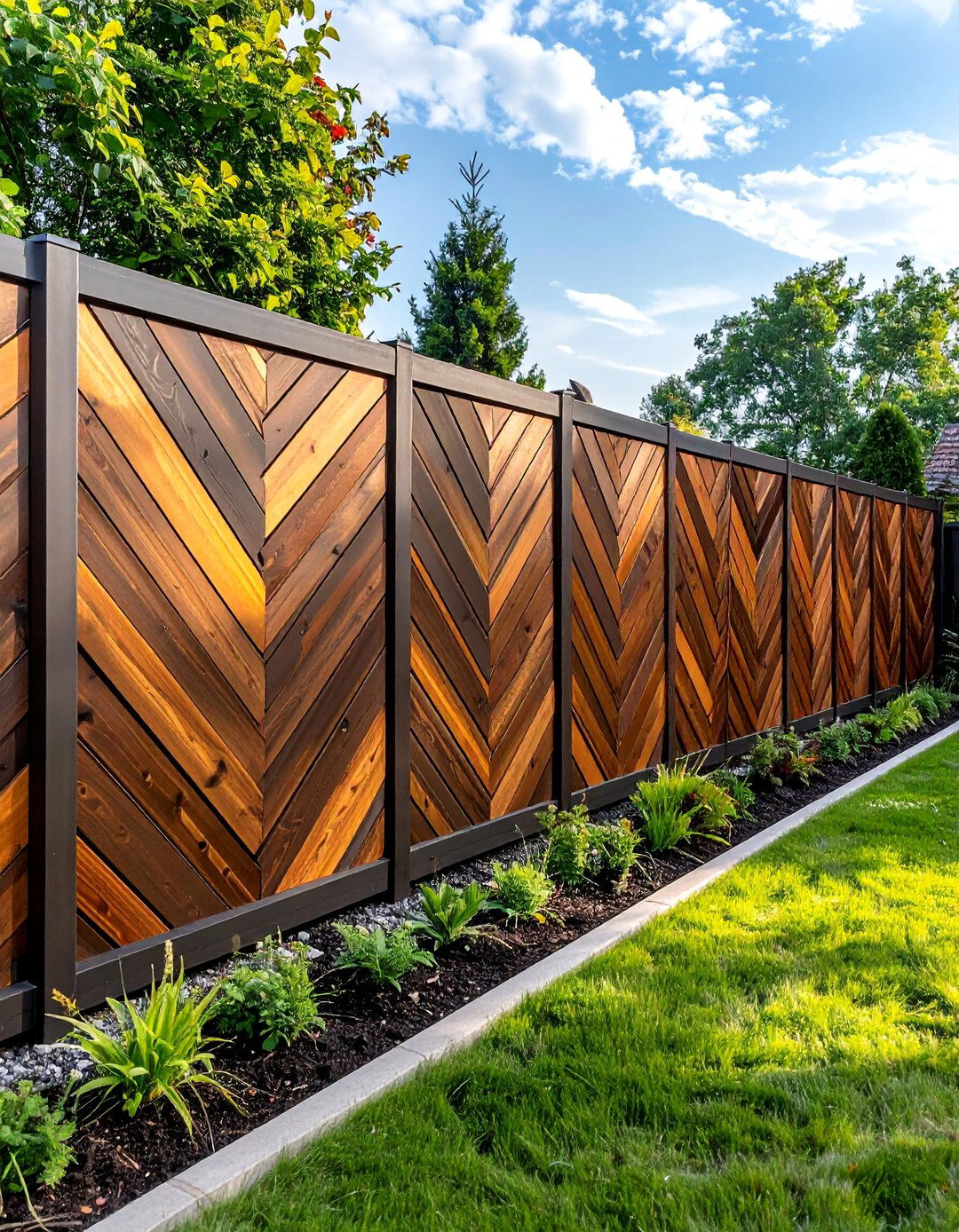
Leave a Reply